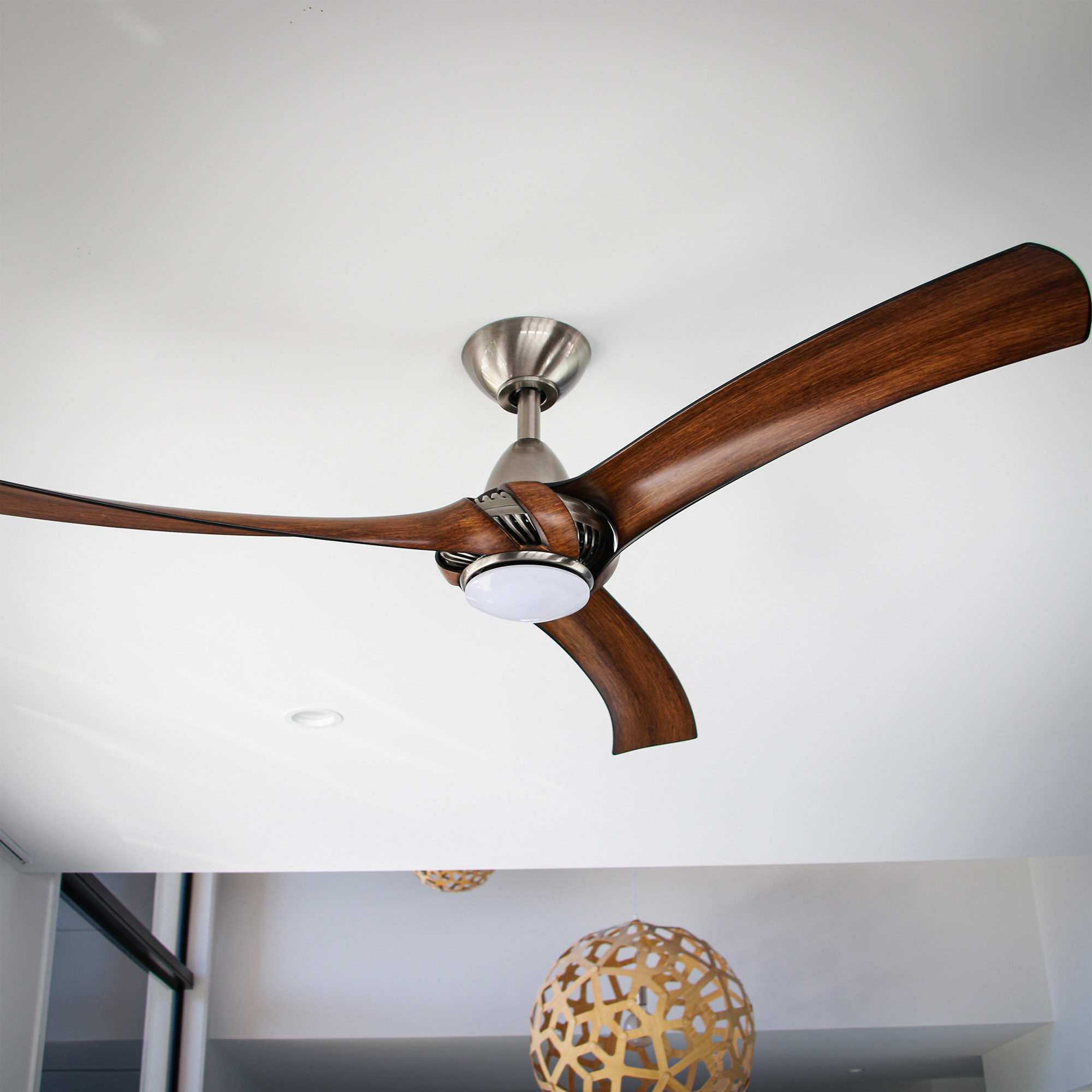Table of Contents
Without seeing a ceiling fan running, it can be difficult and confusing to determine what type of airflow you can expect. That’s why we’ve created our Ceiling Fan Performance Guide to help you make a more infromed decision.
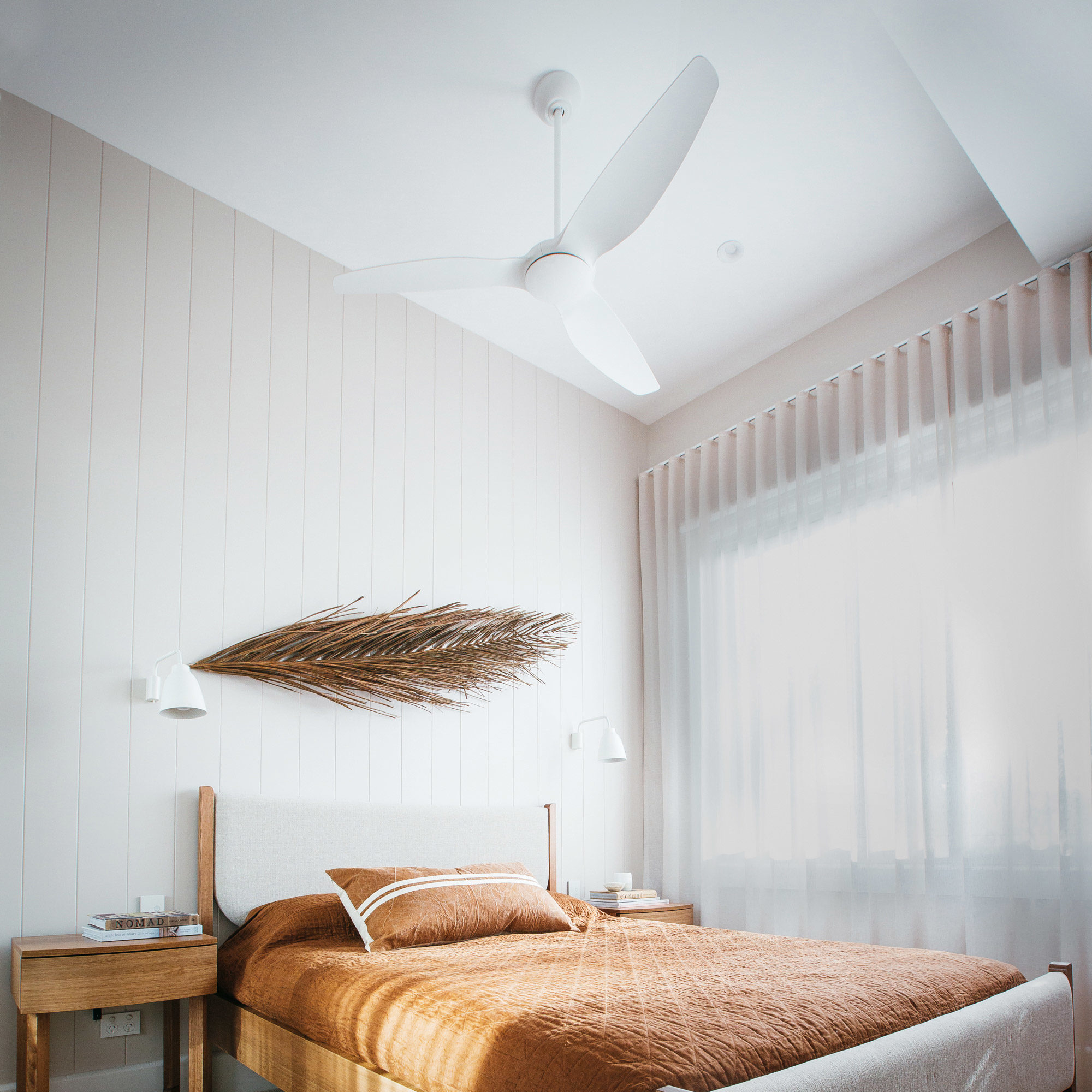
How can I choose a ceiling fan that will provide the right airflow for my space?
The major influencers on the performance of a ceiling fan are the size of the motor, the size and shape of the blades, the material the blades are made of, the RPM of the fan, and the pitch of the fan blades. It is the combination of all of these factors working together that will give your fan the best performance results. However, what works the best functionally may not work the best in terms of style, application for your space, your climate, and most importantly your personal preference.
Ceiling fans are an excellent low-energy appliance to help keep you cool and comfortable on hot and humid days. Ceiling fans cool you down by generating a breeze which creates a wind chill effect. This wind chill effect is increased with the increase in wind speed created from the fan, or its “velocity”. The velocity of wind the fan creates is not the same as the amount or volume of air moved.
“Ceiling fans cool you down by generating a breeze which creates a wind chill effect.”
Manufacturers of ceiling fans often quote the volume of air a fan produces as a metric, Cubic meters per hour or CM/H. While the CM/H metric does give you an idea of the performance of the fan, it does not tell you the full story. For instance, if you are unsure whether you need a 132cm diameter fan or a 152cm diameter fan and you looked to the CM/H of each fan to determine which one would offer the best for cooling you, you would not be evaluating them correctly. If you make this direct comparison, then it is likely that the 152cm diameter fan will have a higher CM/H number as it displaces more air over a larger area but may not create as much wind speed or airflow velocity directly below the fan.
So what should you be looking at to find the right airflow for your space?
The “right” type of airflow depends on a number of factors (where the fan is being installed, the climate you live in, etc.), but the most important is your personal preference. Some people like gentle and quiet airflow, while others prefer powerful airflow. The following sections will help you understand how we’ve graded our fans, how big your fan should be, and how high you should hang it.
- Understand the type of airflow each fan can provide
- Choose the right size fan for your space
- Hang your ceiling fan at an optimal height
Once you know these things, you should be in a solid position to choose the right ceiling fan for your space and to match your personal preference.

Understand the type of airflow each fan provides.
The best way to know what type of airflow a ceiling fan will provide is to stand under it, of course. However, this is not always possible so we have created our Fan Performance Indicator (FPI) rating system to help understand the type of Breeze you can expect under the fan, along with the total volume of air the fan will move at high speed.
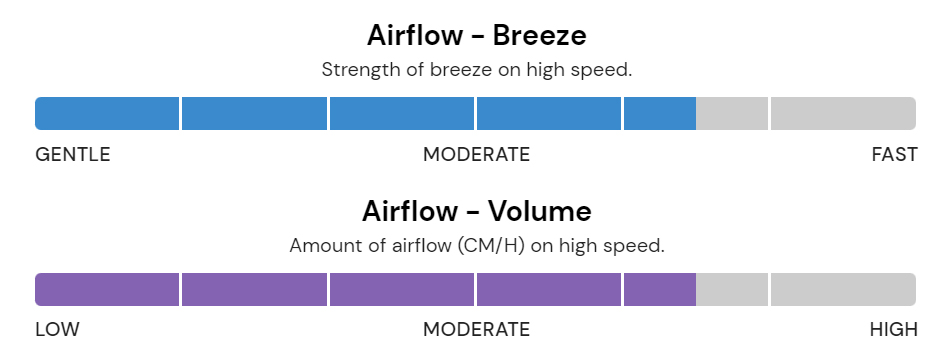
The Fan Performance Indicator (FPI) is split into two bars – the blue bar indicates the ceiling fan’s airflow breeze (wind chill) performance on high speed, while the purple bar indicates the ceiling fan’s airflow volume (CM/H) on high speed.
Airflow – Breeze (wind chill)
The Airflow Breeze rating goes from Gentle to Fast. A ceiling fan that is more towards the Gentle end will provide gentle, relaxing, and extremely quiet airflow directly below the fan. Conversely, a ceiling fan that is towards the Fast end will provide high-velocity airflow directly below the fan, ideal for very hot and humid climates or if you prefer strong airflow.
Airflow – Volume (CM/H)
The Airflow Volume rating takes the ceiling fan’s Cubic Metre per Hour (CM/H) measurement and normalises the results across our entire range of ceiling fans and based on our industry experience on how much air ceiling fans typically move. A ceiling fan towards the Low end will move less air overall, and would therefore not be recommended for larger spaces but may be perfectly suitable for smaller areas. Conversely, a ceiling fan towards the High end moves a lot of air and will disperse the air over a larger area.
Using Breeze and Volume together to make an informed decision
Separately, neither indicator paints the whole picture of your ceiling fan’s performance. Together, though, they can be used to make a much more informed decision without being able to see the fan in operation. Below, we have covered a few different examples to help show different cooling solutions and when they might be recommended.
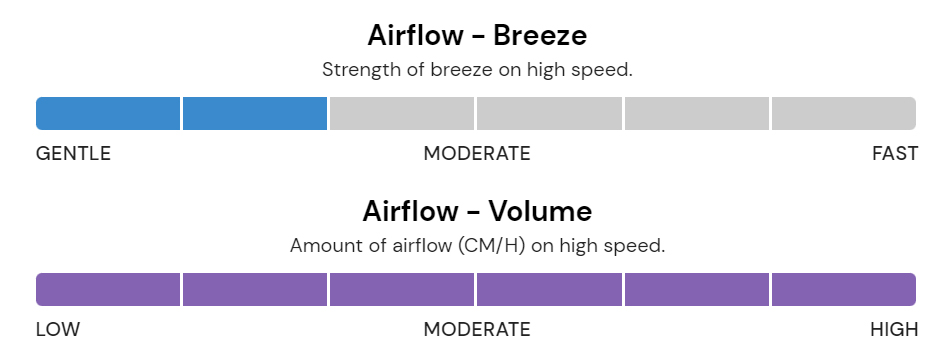
The above FPI results from our massive 100″ Kirra ceiling fan show a more gentle airflow breeze solution with very high airflow volume. This particular model falls into the High Volume Low Speed (HVLS) genre of ceiling fans. It is designed to move huge volumes of air but at a low velocity. The breeze you would experience directly under the fan would be gentle, however, due to the size of the fan (100 inches), you would enjoy a breeze in a much larger area. This fan would be ideal for very large spaces that could benefit from air circulation – e.g. moving warm air around a space in winter to improve heating, moving air-conditioned air around a large space to improve cooling performance, or keeping the air in a large space fresh. Some applications might be large foyers, restaurants, large high-ceilinged dining areas, large living areas, and so forth.

The above FPI results from our 52″ Modn-3 ceiling fan show a midrange model in terms of breeze and airflow volume. This type of model would suit smaller enclosed spaces (e.g. bedrooms) if you like a gentle breeze while you sleep, or any space where you want a breeze but don’t enjoy extremely strong airflow. It may suit dining areas and lounge areas where a gentle breeze is desired, without disturbing the conversation or table settings.
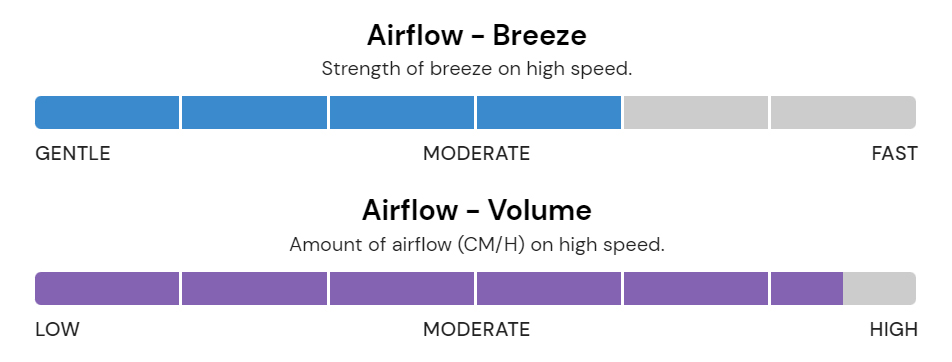
The above FPI results from our 60″ Spitfire ceiling fan show a ceiling fan that will provide moderate airflow directly below and spreading out from the fan. This is because at 60 inches it is an above-average size ceiling fan that will therefore disperse air over a larger area. Great for master bedrooms, larger living and dining areas where solid airflow is desired while being whisper-quiet.
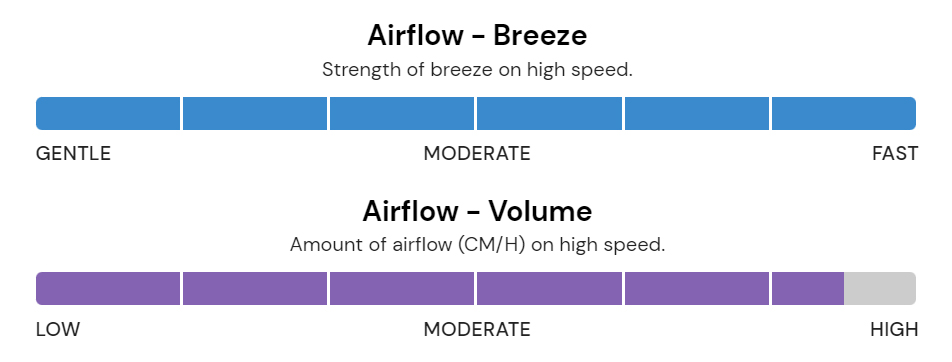
Finally, the above FPI results for the 56″ Delta DC ceiling fan show a high-performance solution that will provide a strong breeze directly below the fan while also providing good overall airflow volume for your space.
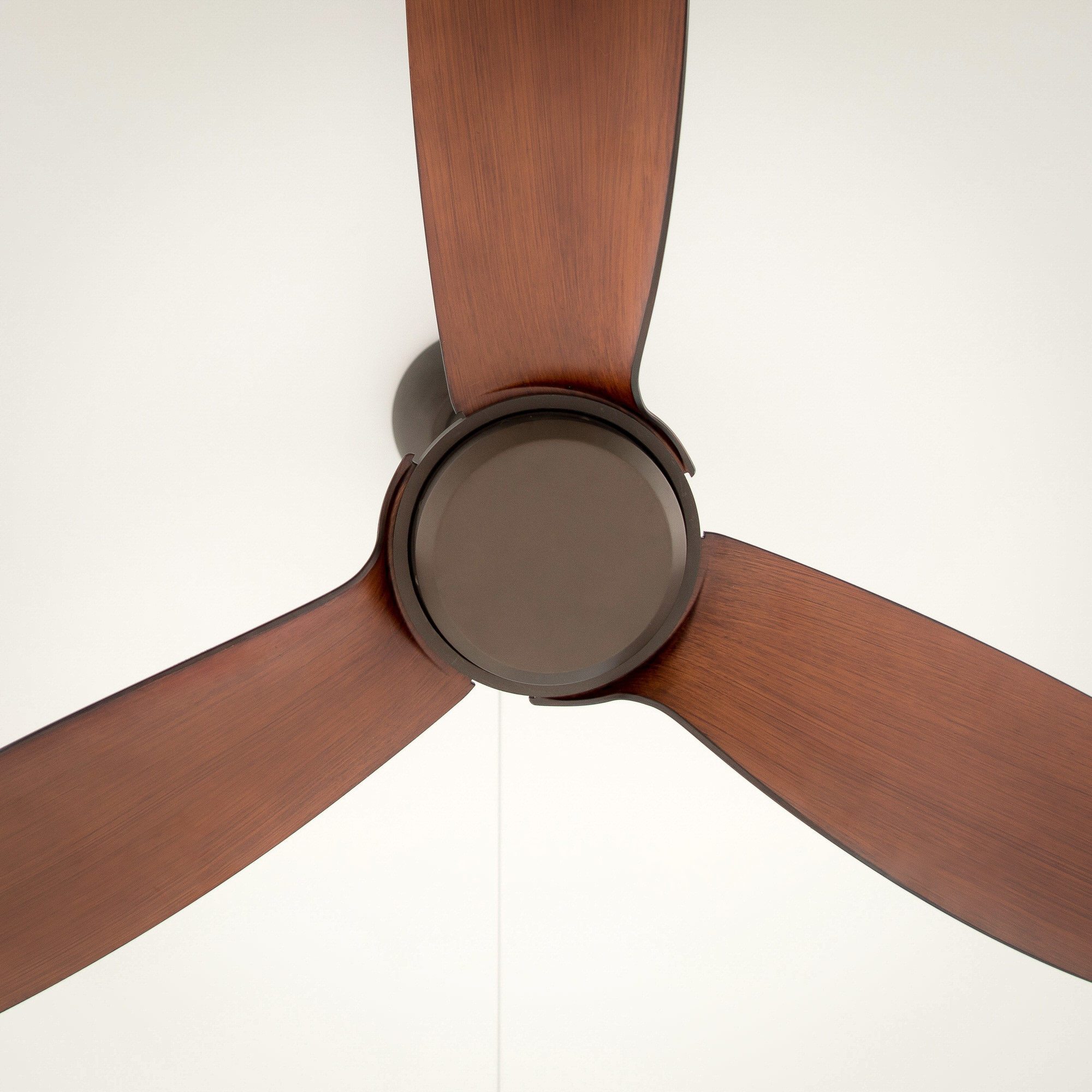
The number of blades on a ceiling fan is not a reliable indicator of performance.
Don’t focus too much on the number of blades on your ceiling fan. Yes, blades are an important part of your ceiling fan and the number of blades does impact ceiling fan performance. However, there are many factors that influence ceiling fan performance – blade pitch, blade aerodynamics, motor performance – which all need to be considered in order to determine overall performance.
So the number of blades, on its own, is not a reliable indicator of performance. A three blade ceiling fan may be better or worse than a four-blade fan, a four-blade fan may be better or worse than a five-blade fan, and so on. We have published our Fan Performance Indicator (FPI) on all our Data Sheets and also on every product page. The FPI should be used to help identify models that will offer you the right type of cooling based on your personal preference and requirements.
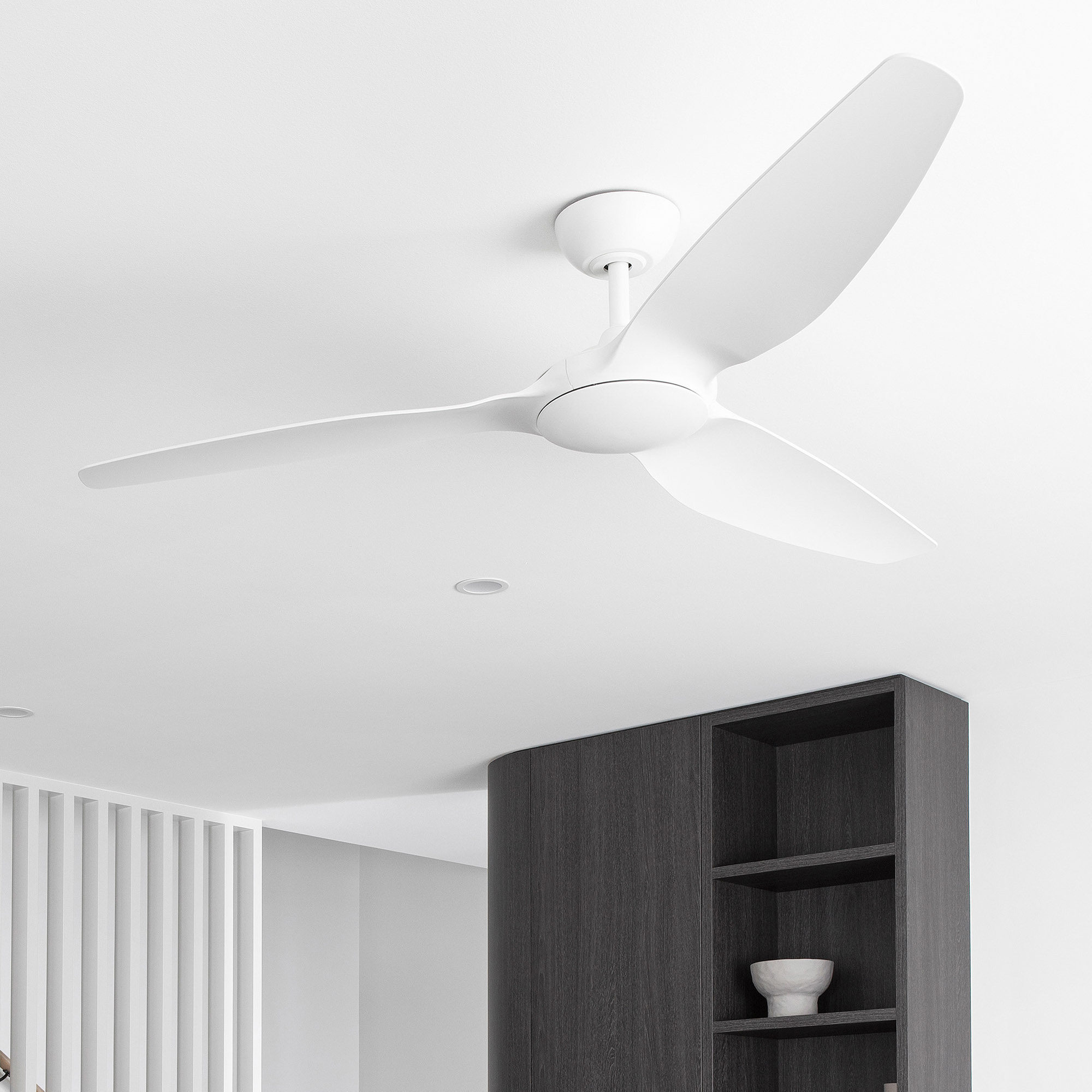
Ceiling fans also provide indirect cooling through air circulation
A factor to consider with your ceiling fan’s performance is its ability to circulate the air. A fan’s effectiveness is not only its ability to cool whatever is beneath it, but you will also get benefits from the fan circulating air throughout the room.
In an average-sized room with an average size fan, the continued forcing of the air down towards the floor will see the air dissipate outwards to the room walls and up until the air has circulated back to the fan, creating a circular flow within the room. This circular flow provides you with the best application of your ceiling fan for full effect. Factors that may limit your ceiling fan’s performance are if the fan cannot draw enough air from above, if the fan is too close to a wall and the flow is interrupted, or if the fan is obstructed by an air conditioning duct and provides uneven amounts of air.
When using fans in a patio or an outdoor situation the circulation of air is affected by the fact that there are no walls present to feed the air back to the fan. So for outdoor applications of ceiling fans, the velocity and the CM/H of the fan is most important as the air provided will be forced down and simply be lost in the outdoor environment. Fortunately, when fans are used outdoors it is generally not in a sound-sensitive environment so a high velocity, high RPM fan will provide adequate cooling and breeze in these situations.
To ensure your ceiling fan provides optimal performance, you need to ensure you choose the right size ceiling fan and hang the fan at the right height.
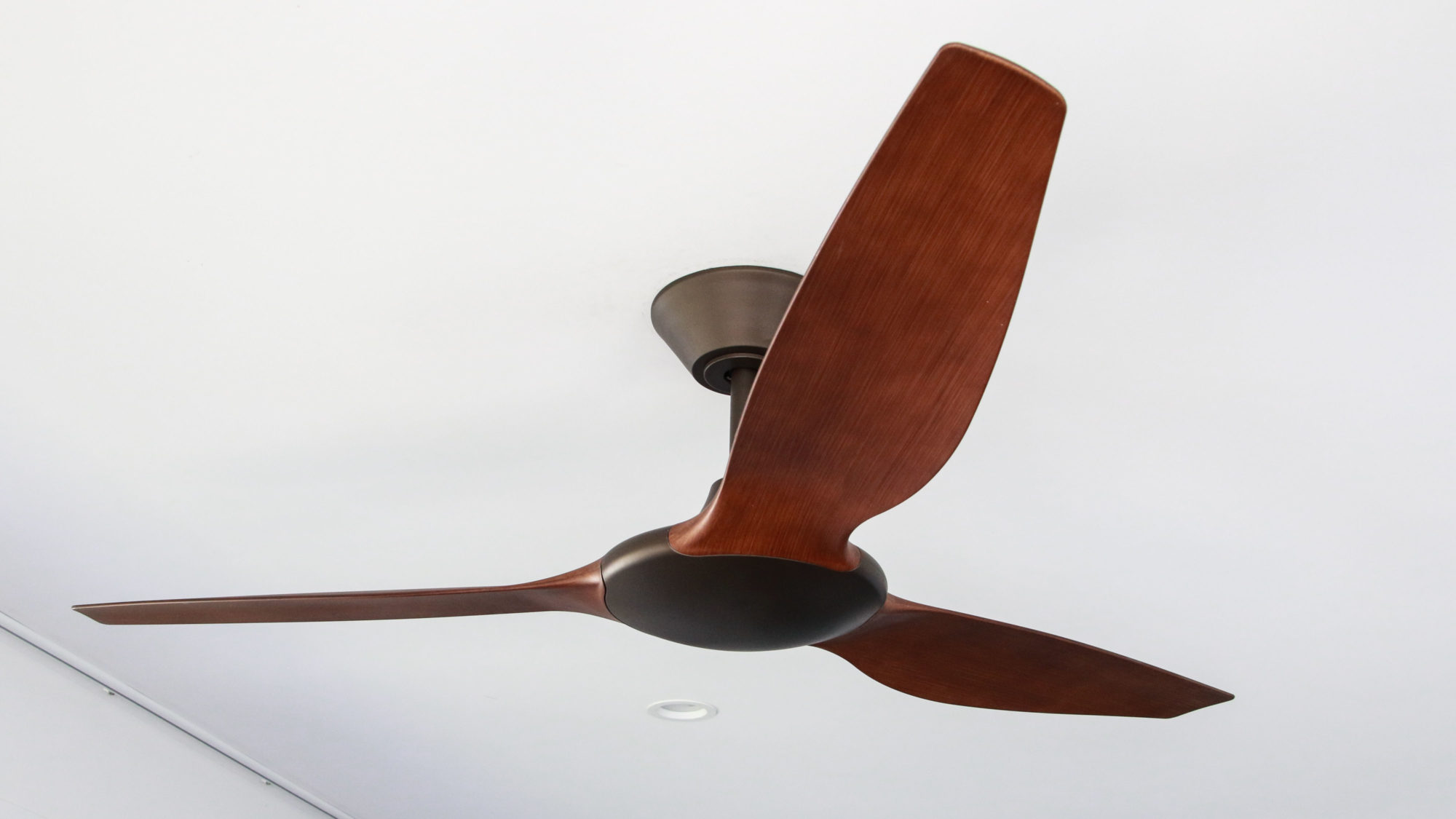
Choose the right size ceiling fan for your space
There’s no exact science to selecting the right size ceiling fan for a space (as every room layout is different), but the following sections will help guide you in the right direction. Always ensure at least 50cm of space from the tip of any blade to any wall. Pay attention to high furniture or floor-to-ceiling wardrobes to make sure they won’t reduce your fan’s performance.
“Always ensure at least 50cm of space from the tip of any blade to any wall.”
Small spaces (small bedrooms, offices, media rooms, etc.)
For small spaces less than 3m x 3m, we would recommend 48″ or smaller ceiling fans. A small Australian bedroom is around 2.8m x 2.5m, in which space we would recommend a 44″ ceiling fan, although depending on the room layout a 48″ would still suit. For small spaces, consider your lighting requirements – you will most likely require a light kit on your ceiling fan. Having a 48″ ceiling fan in a small space may dominate the decor in the room – so consider the style of the ceiling fan to be installed.
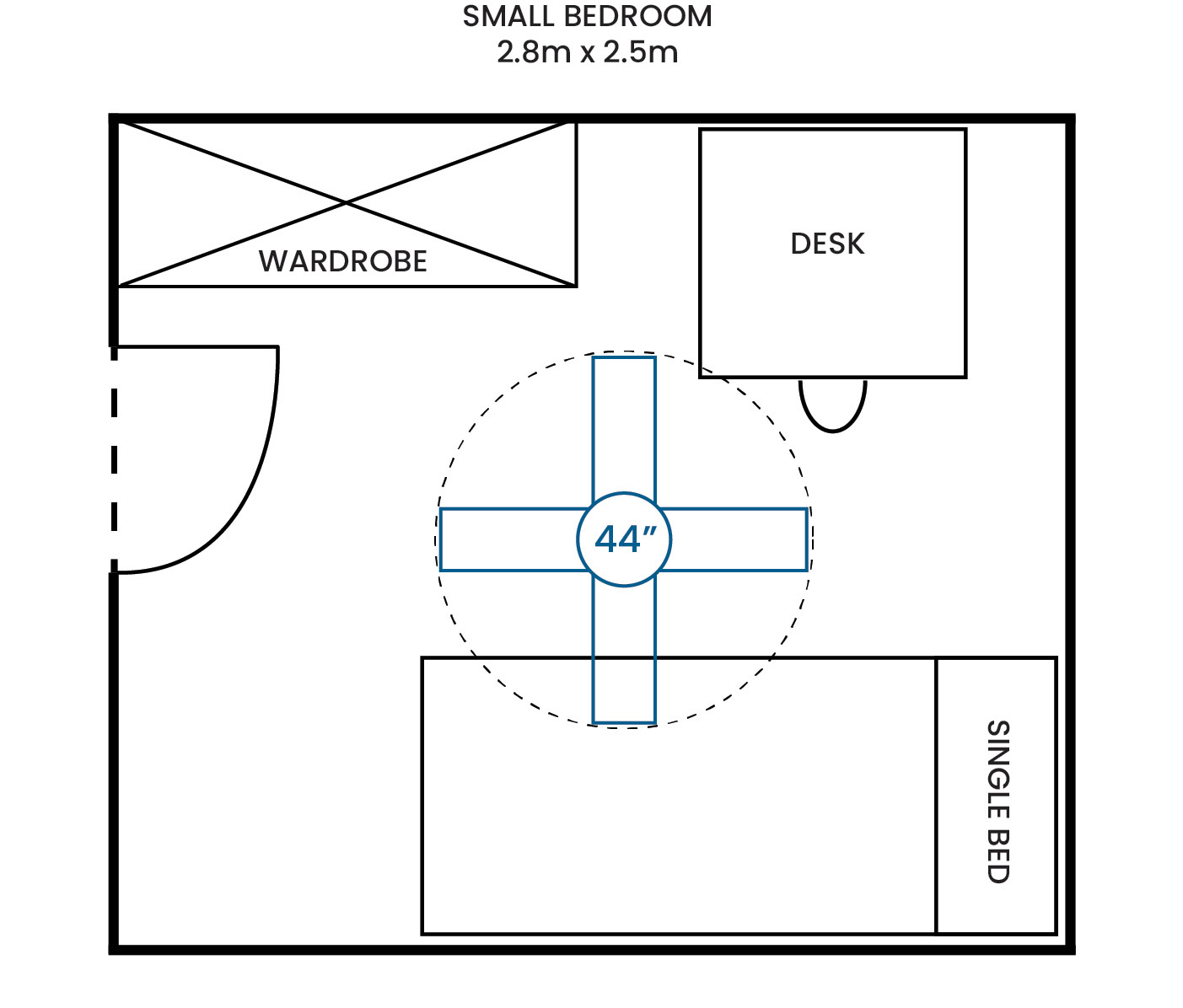
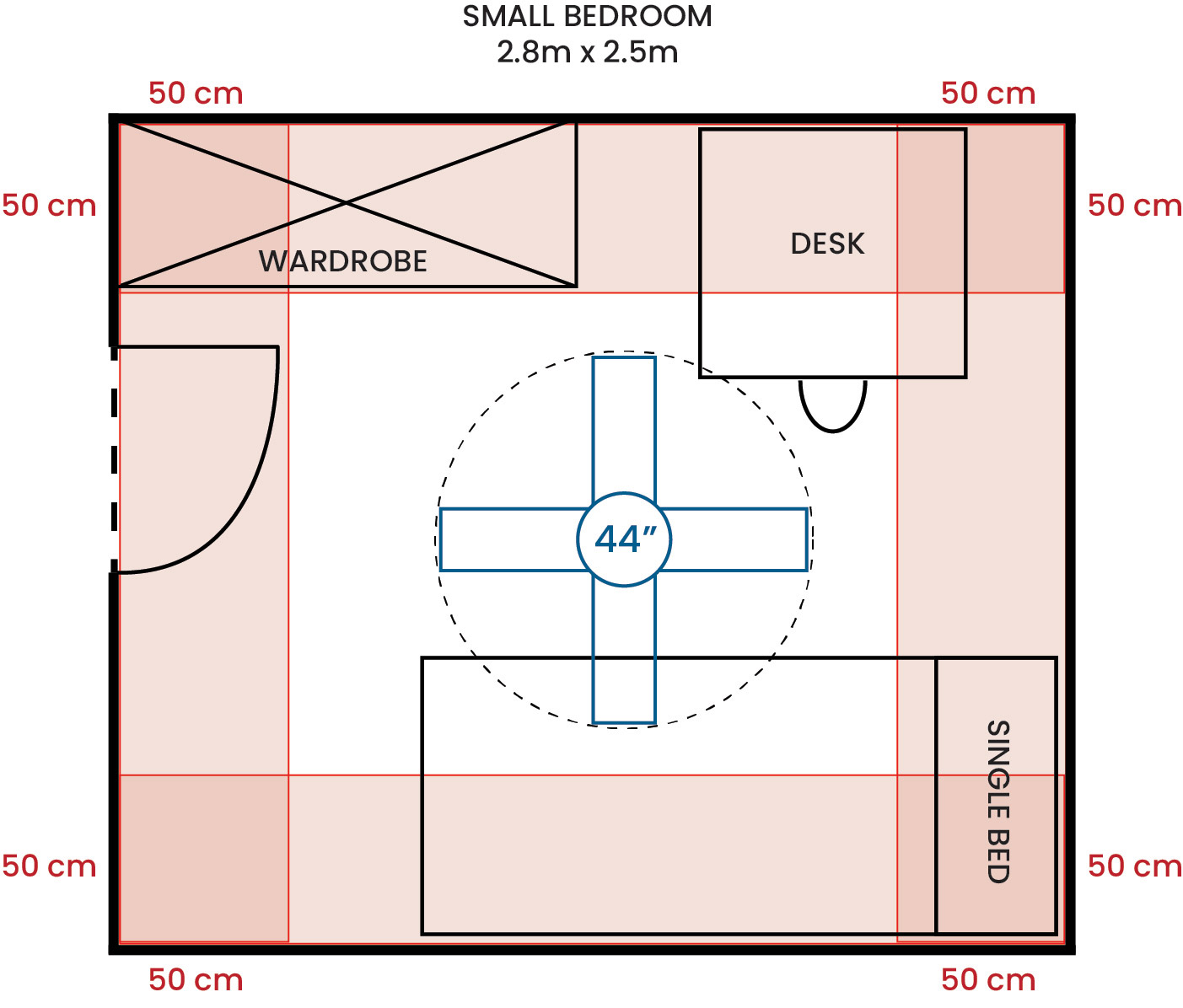

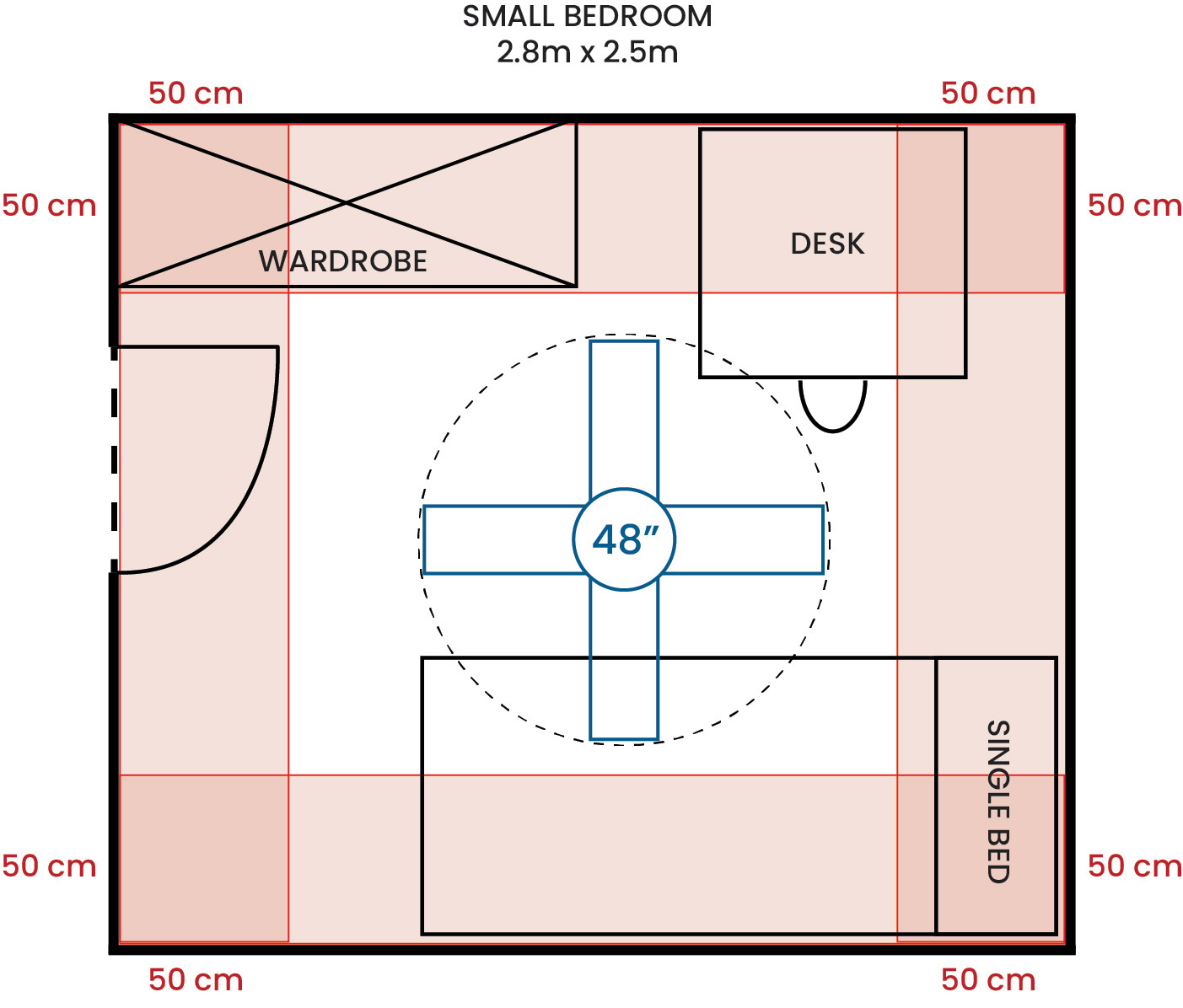
Medium spaces (standard bedrooms, living areas, dining area, etc.)
For medium spaces that are between 3m x 3m and 4m x 4m, consider ceiling fans between 48″ and 56″ in size, depending on the exact size of your room. The average bedroom size in an Australian home is around 3.2m by 3.0m, in which space we would recommend a 52″ ceiling fan. For larger than average bedrooms, up to 56″ model sizes may be suitable. A 56″ model in the standard bedroom would fit (depending on layout), however may dominate the space and provide too much airflow volume.
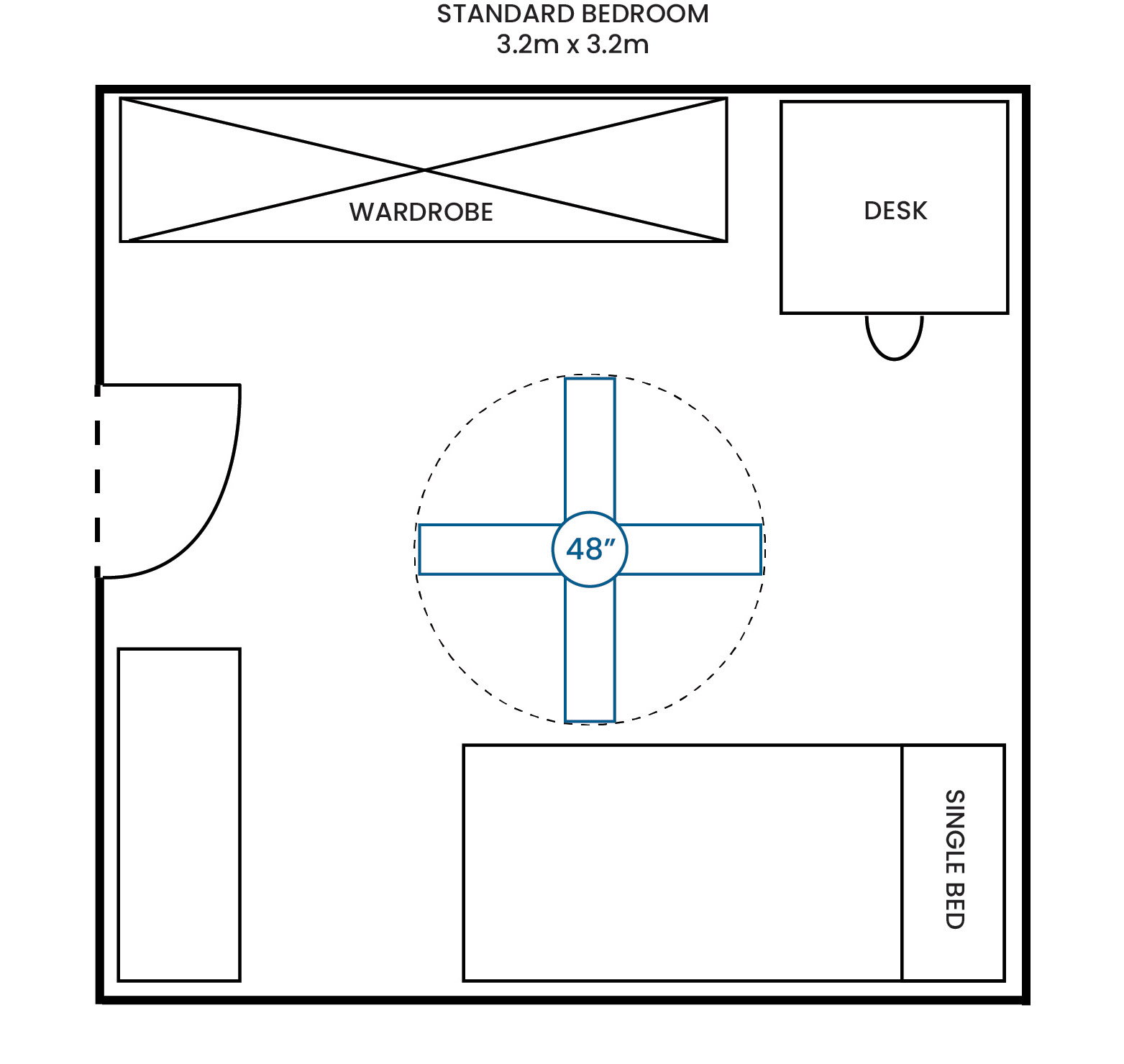
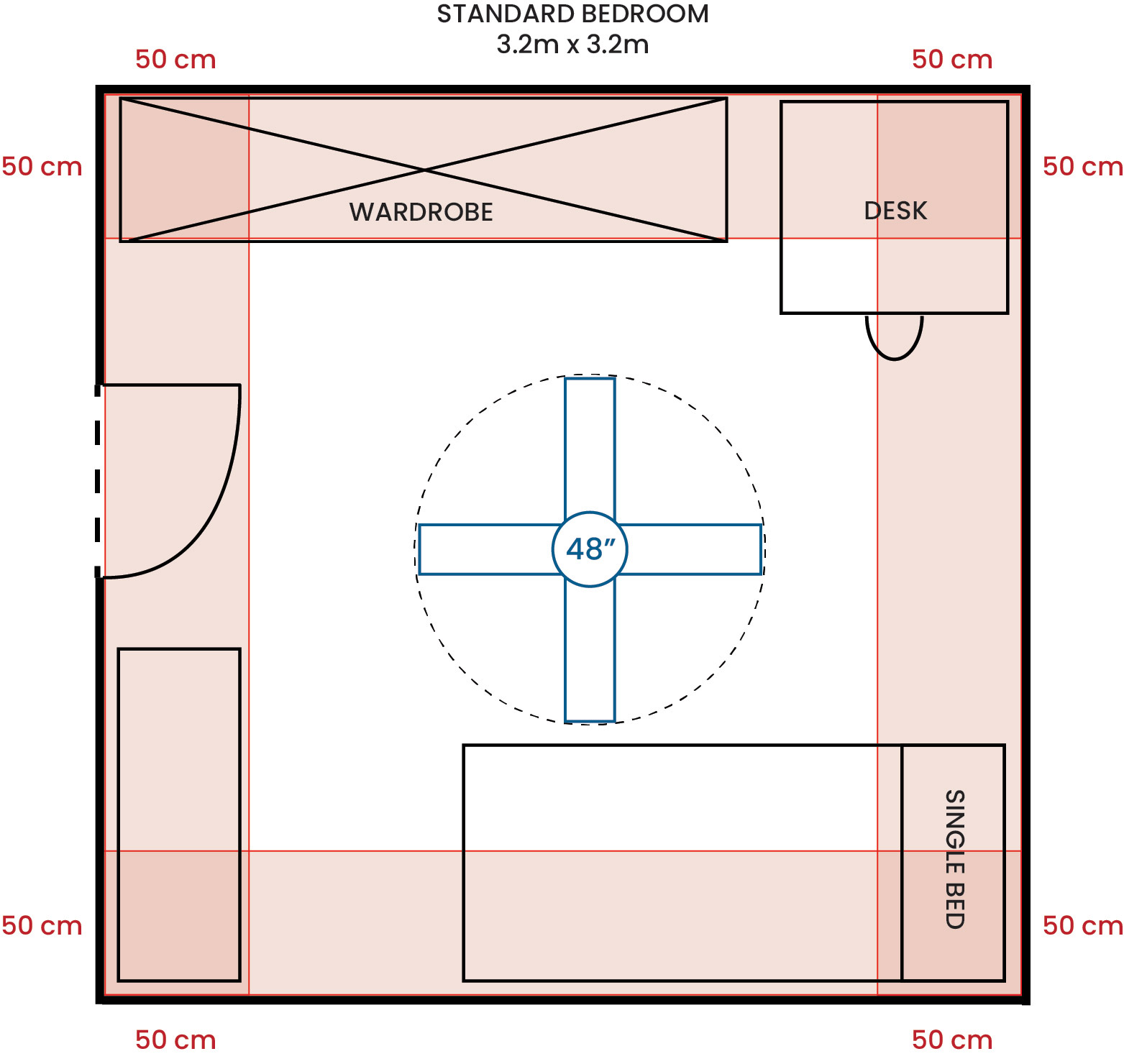

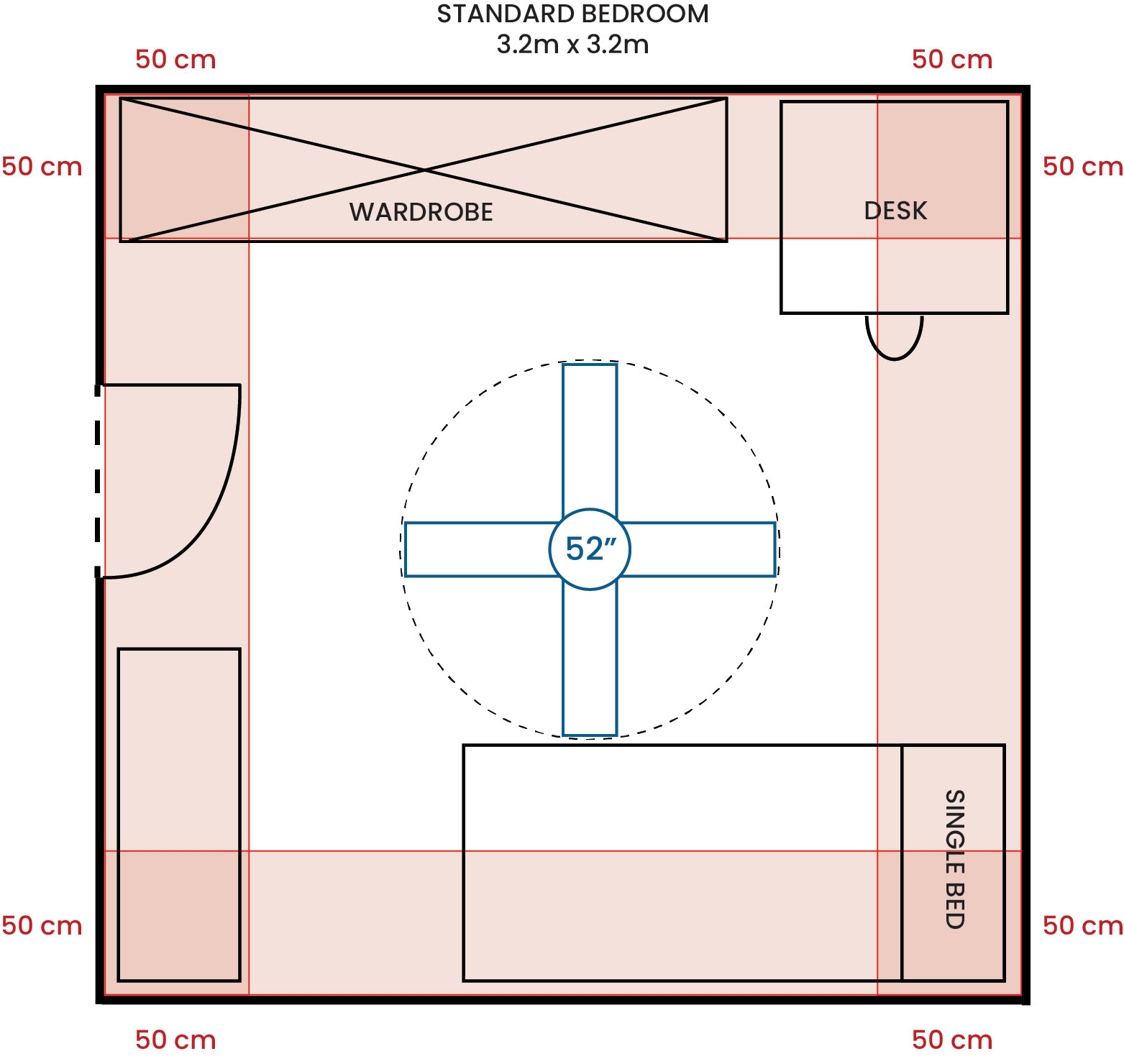
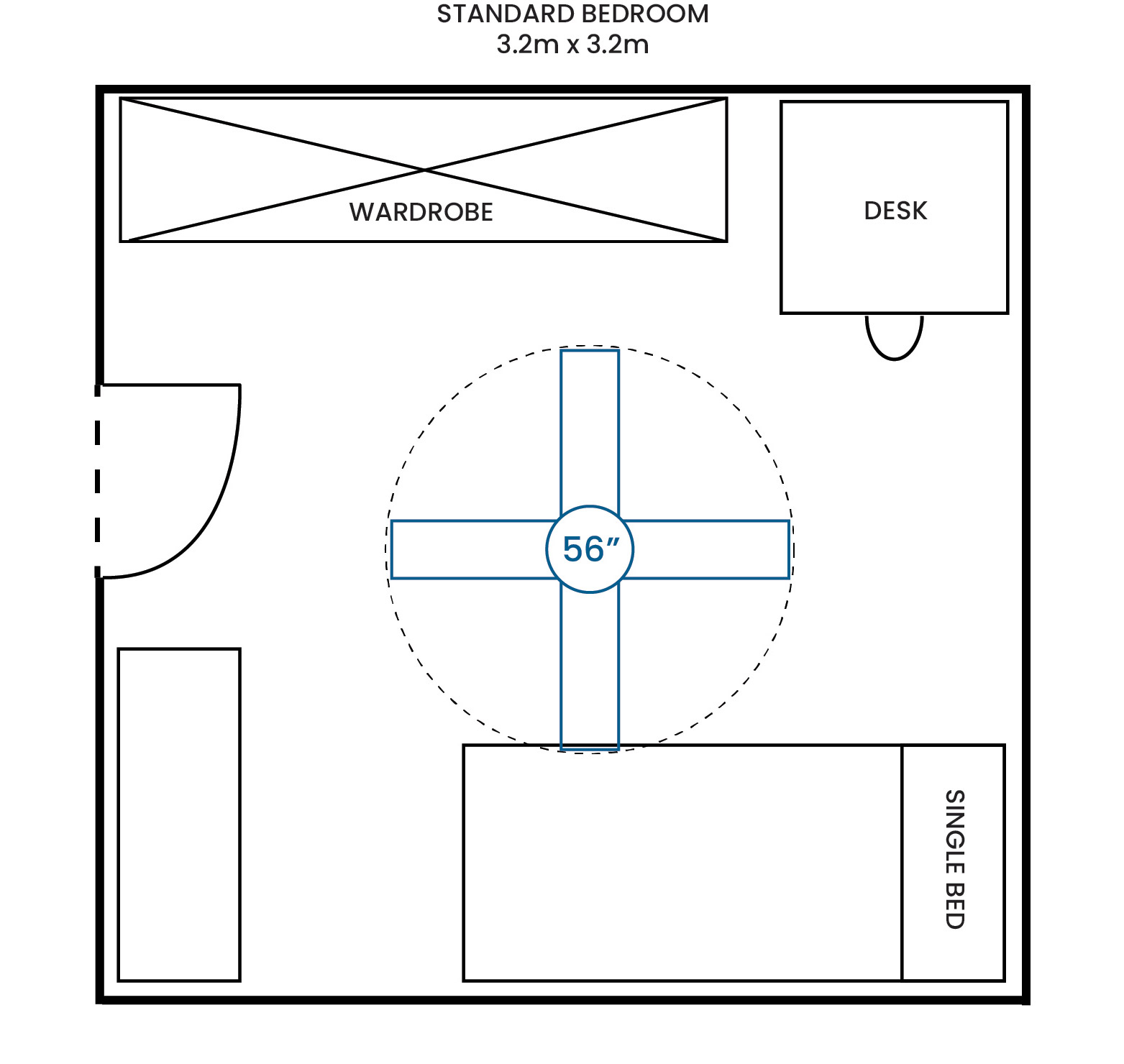

The average standard Master Bedroom in an Australian home is 4m x 3.8m and blurs the line between medium and large spaces. This would allow for ceiling fans up to 60″ in diameter, although a 52″ ceiling fan positioned directly over the bed would still provide the necessary cooling while you sleep. A small Master Bedroom that is 3.5m x 3.5m would suit either a 52″ or 56″ ceiling fan.
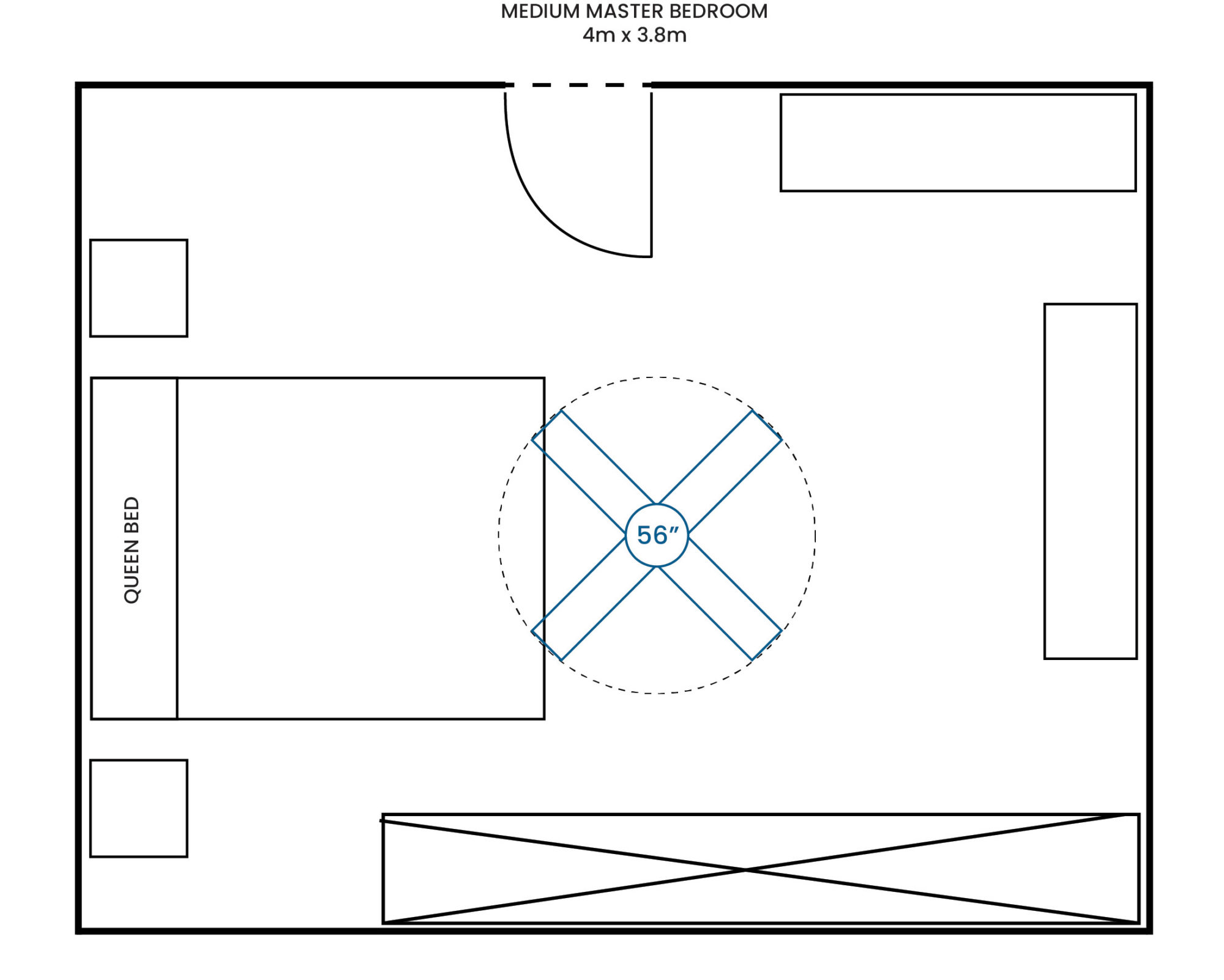
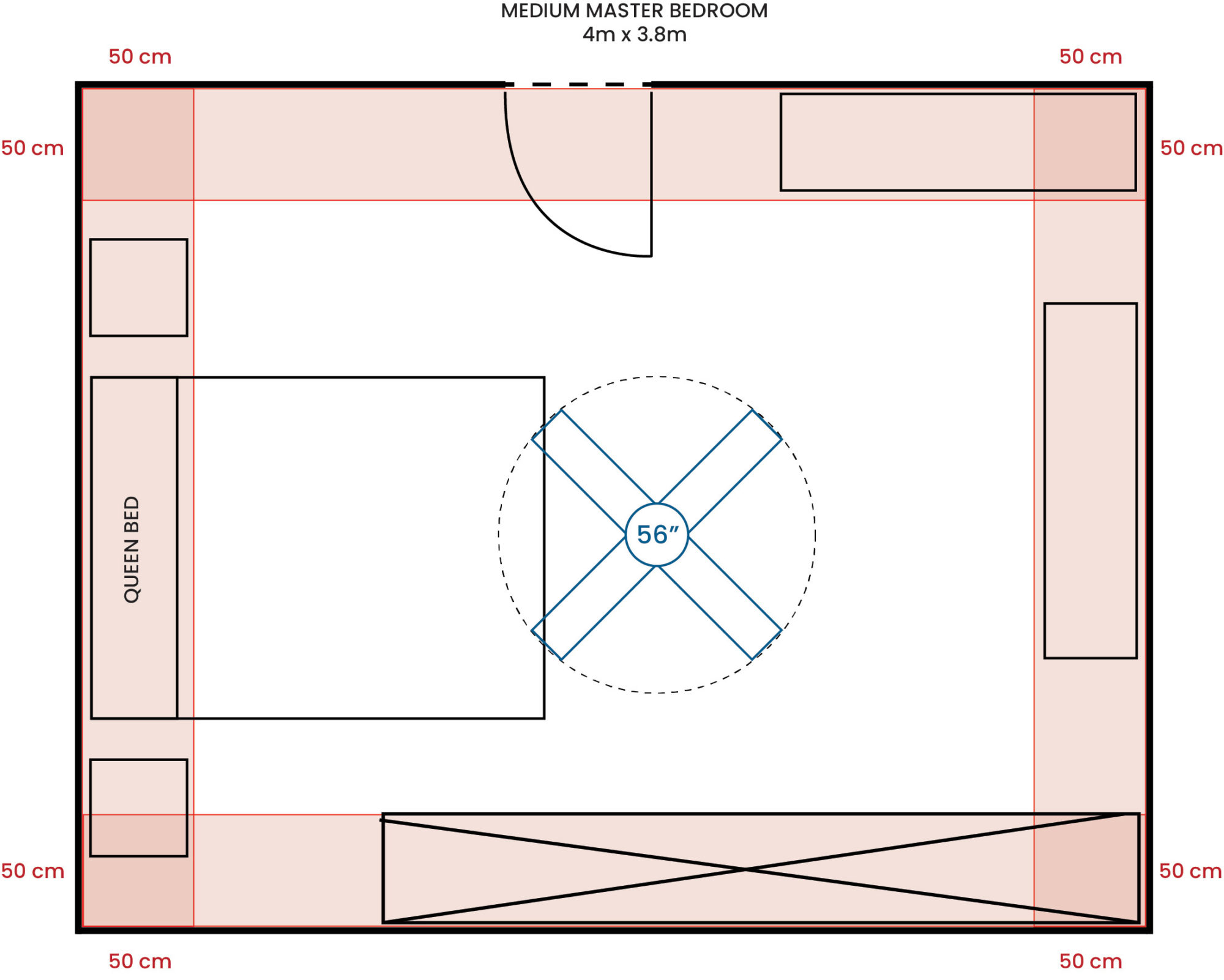
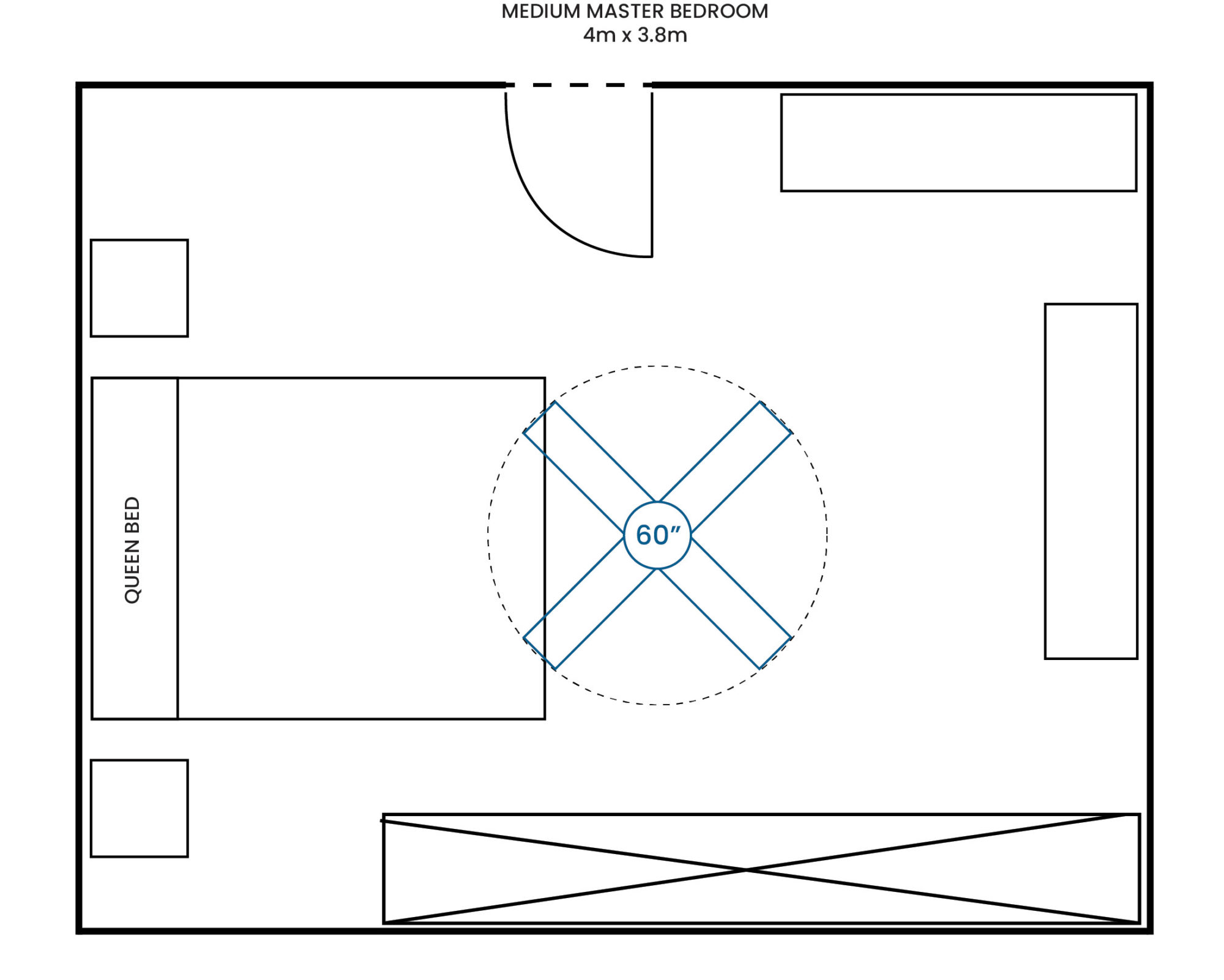
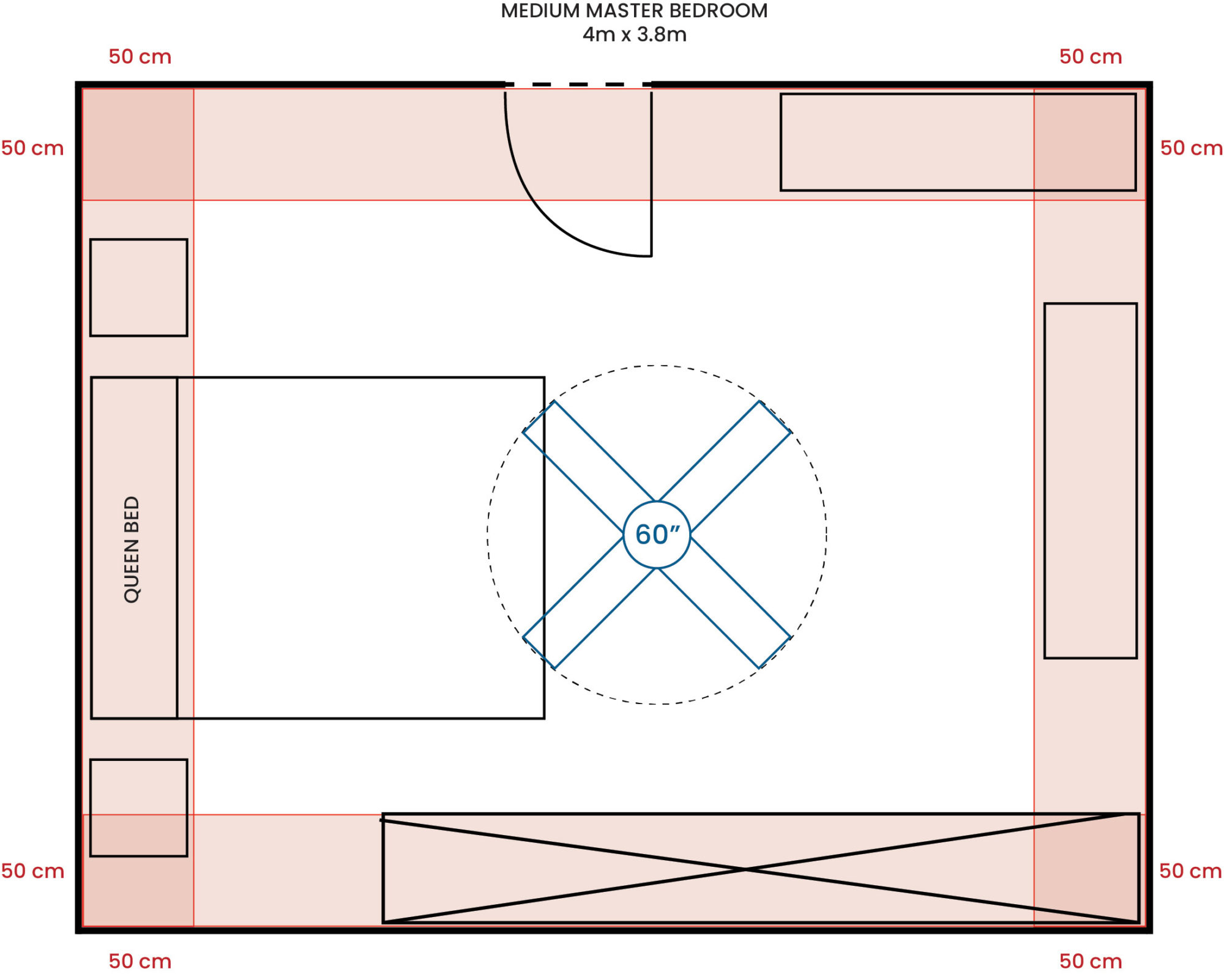
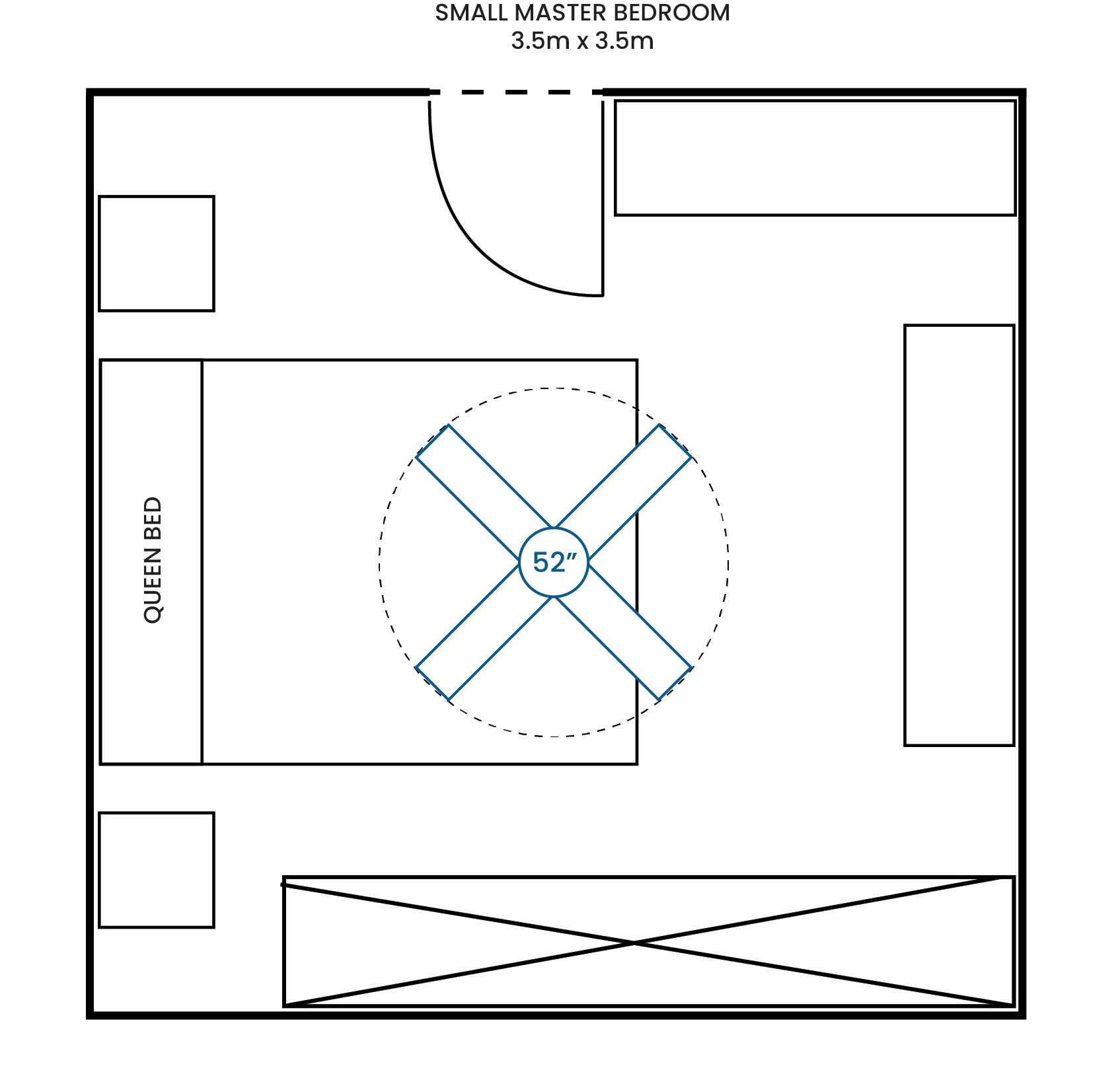

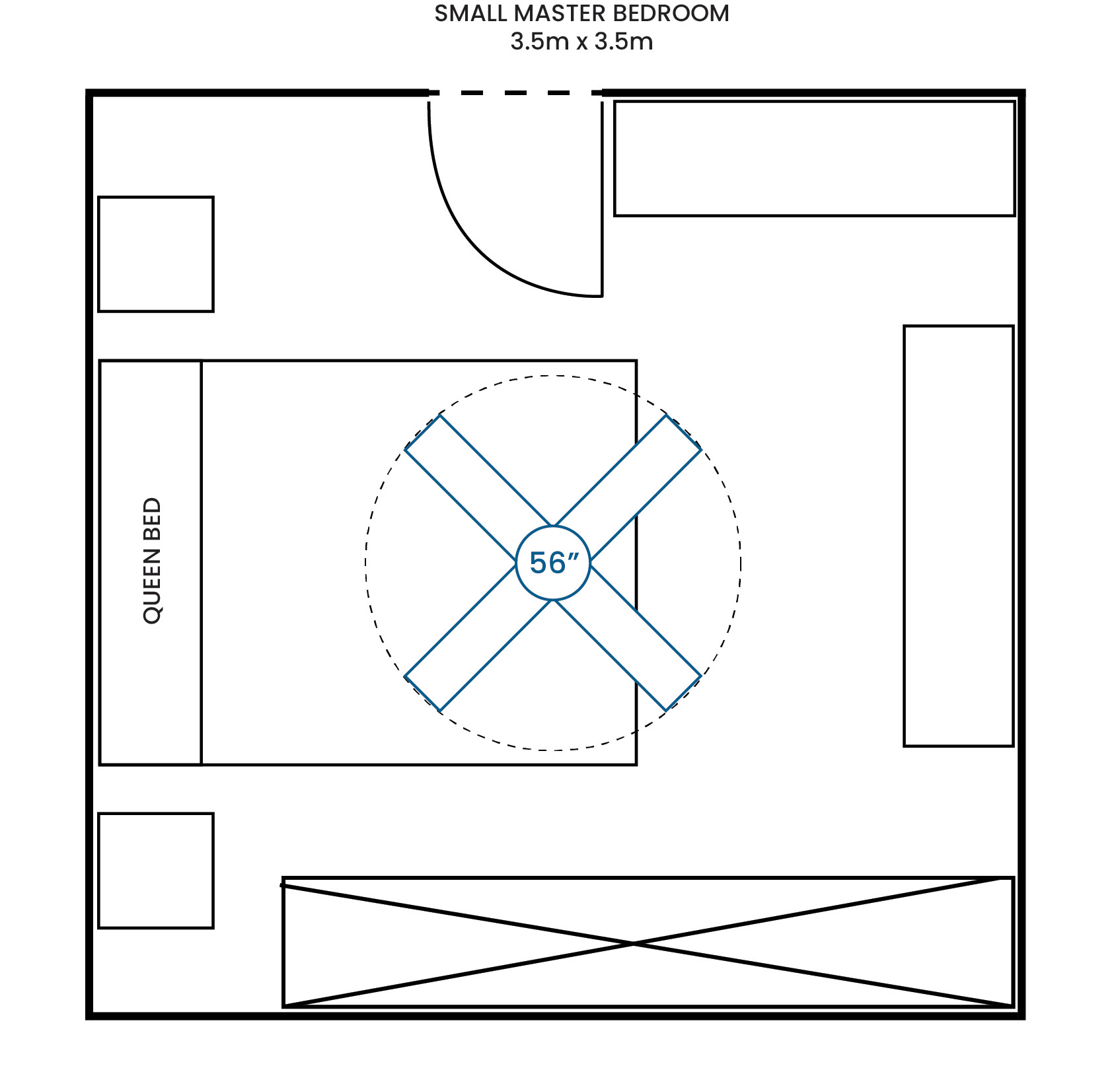
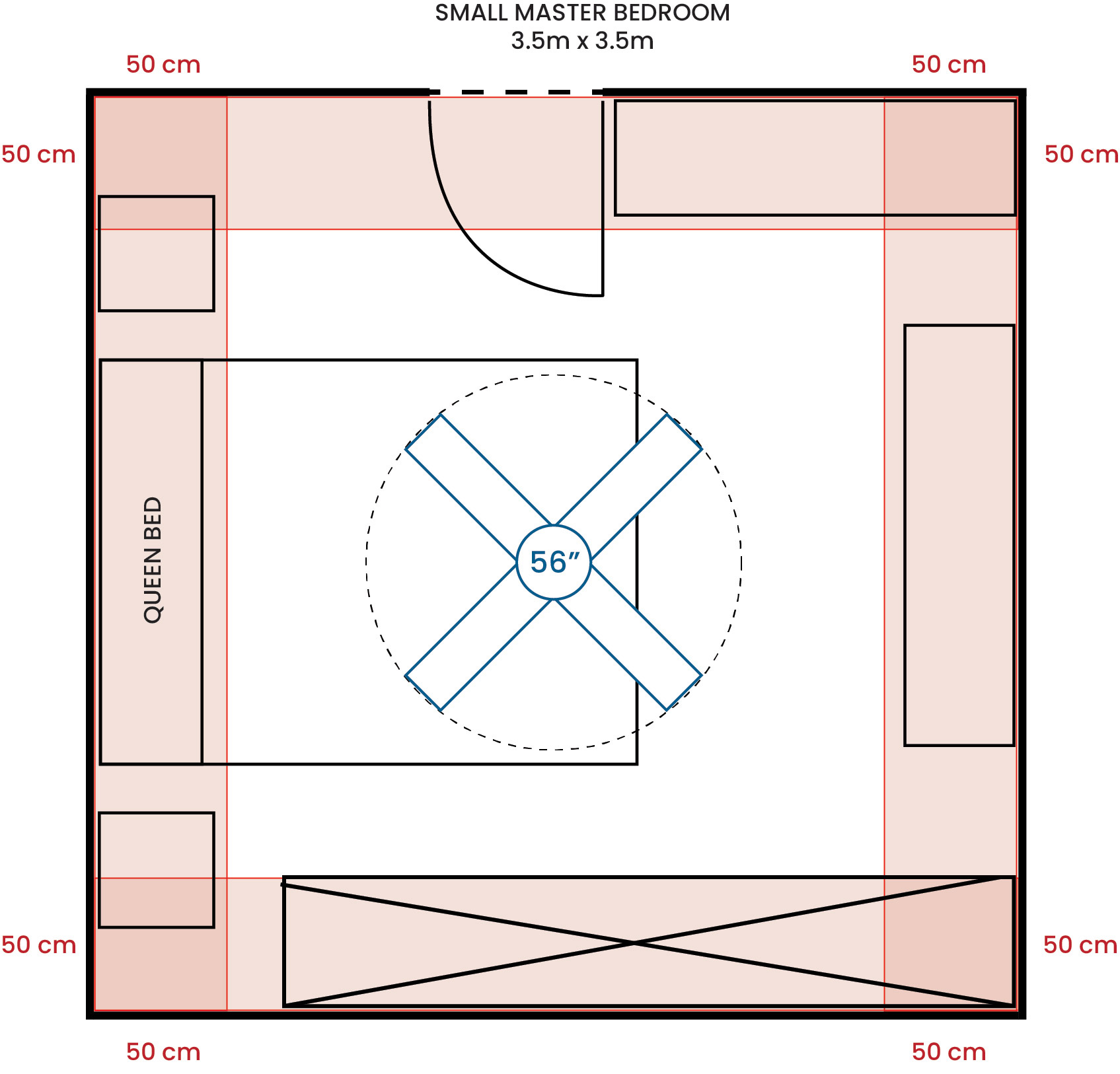
The average Living Room in an Australian home is 4.2m x 3.4m and suits models between 52″ and 56″ in diameter. Try to position your ceiling fan over key gathering points – e.g. the couch in a living room – to provide the most cooling.

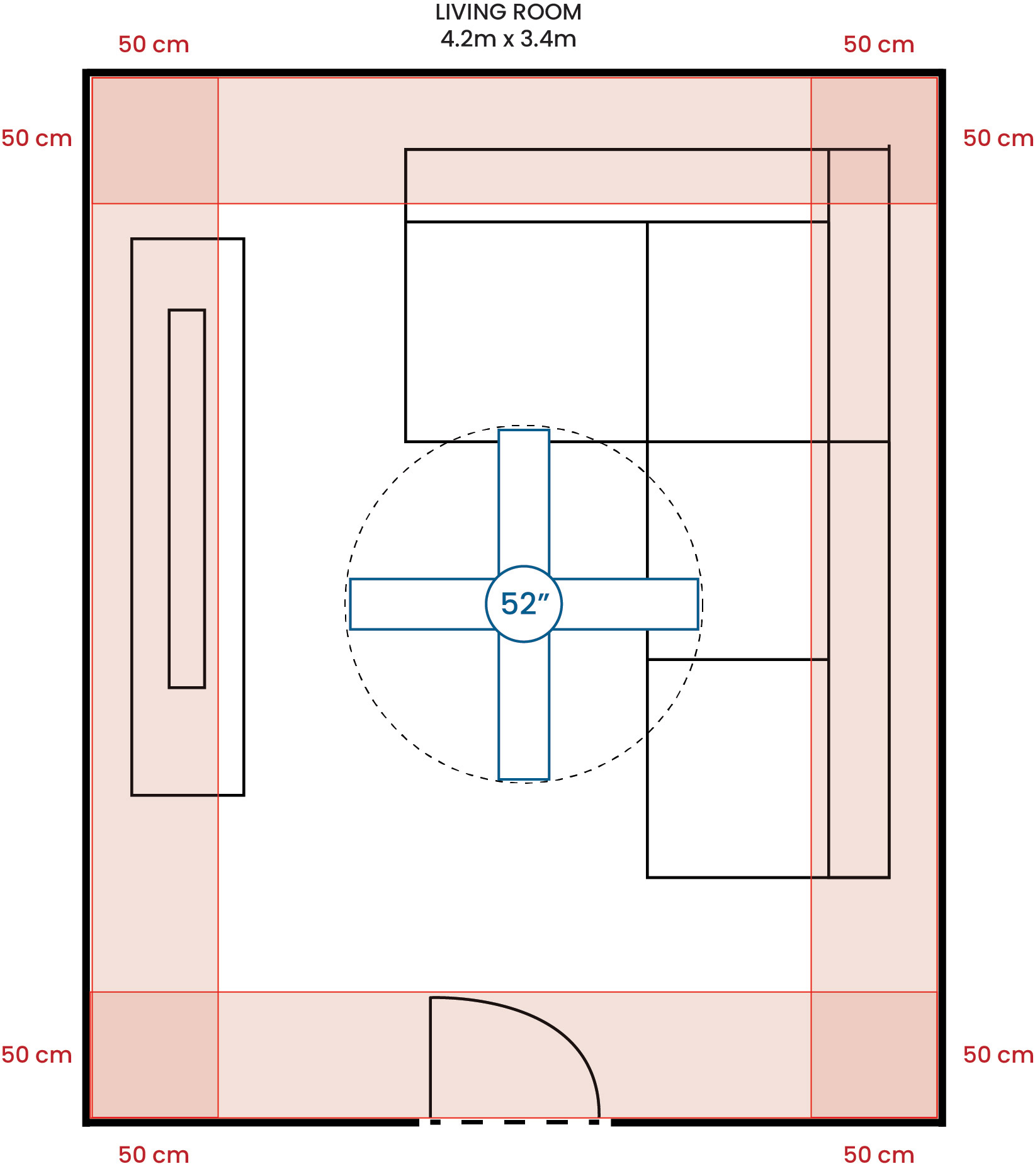
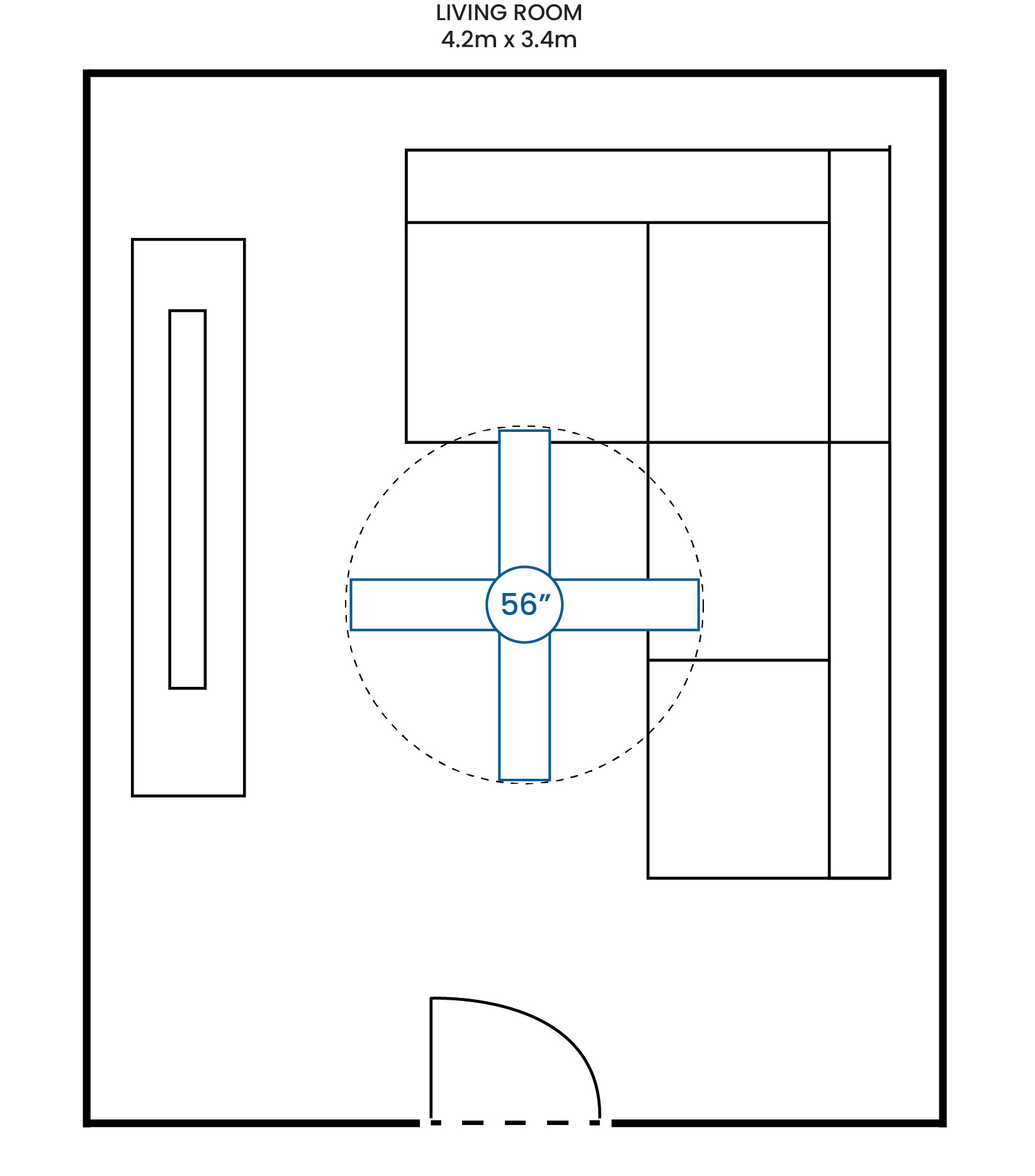

Large spaces (large master bedroom, large living areas, dining area, etc.)
For large spaces that are over 4.0m x 4.0m, consider ceiling fans that are over 56″ in size. An average master bedroom in Australia is 4.2m x 3.9m, which would suit a 56″ blade span ceiling fan. For very large spaces, it is often more effective to install multiple smaller ceiling fans located over specific gathering points (couch, dining table, etc.) as opposed to one large ceiling fan.
A very large master bedroom (e.g. 5m x 4.2m) may suit a ceiling fan up to 70″ in diameter for people that enjoy a gentle, quiet ceiling fan while they sleep.
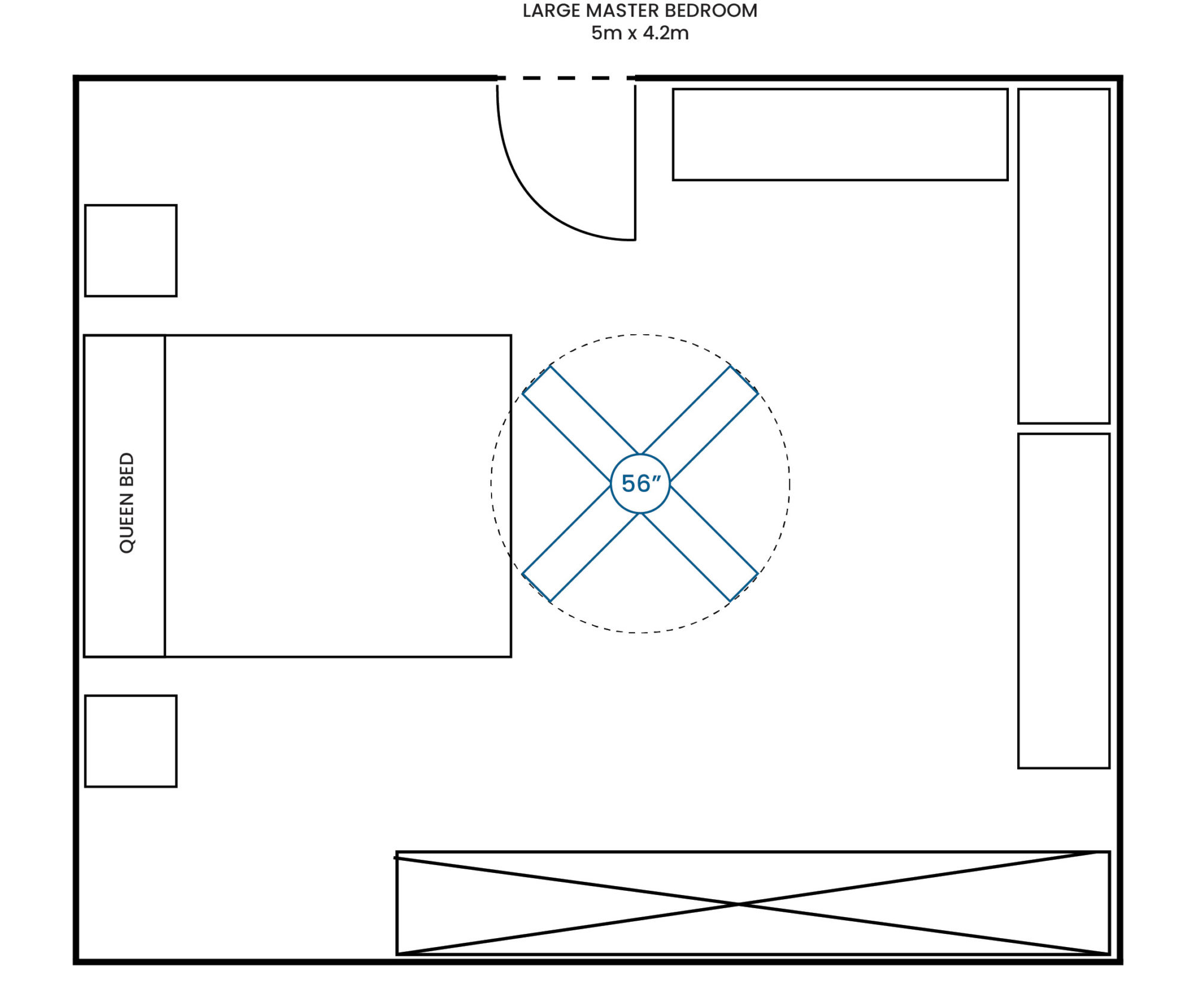

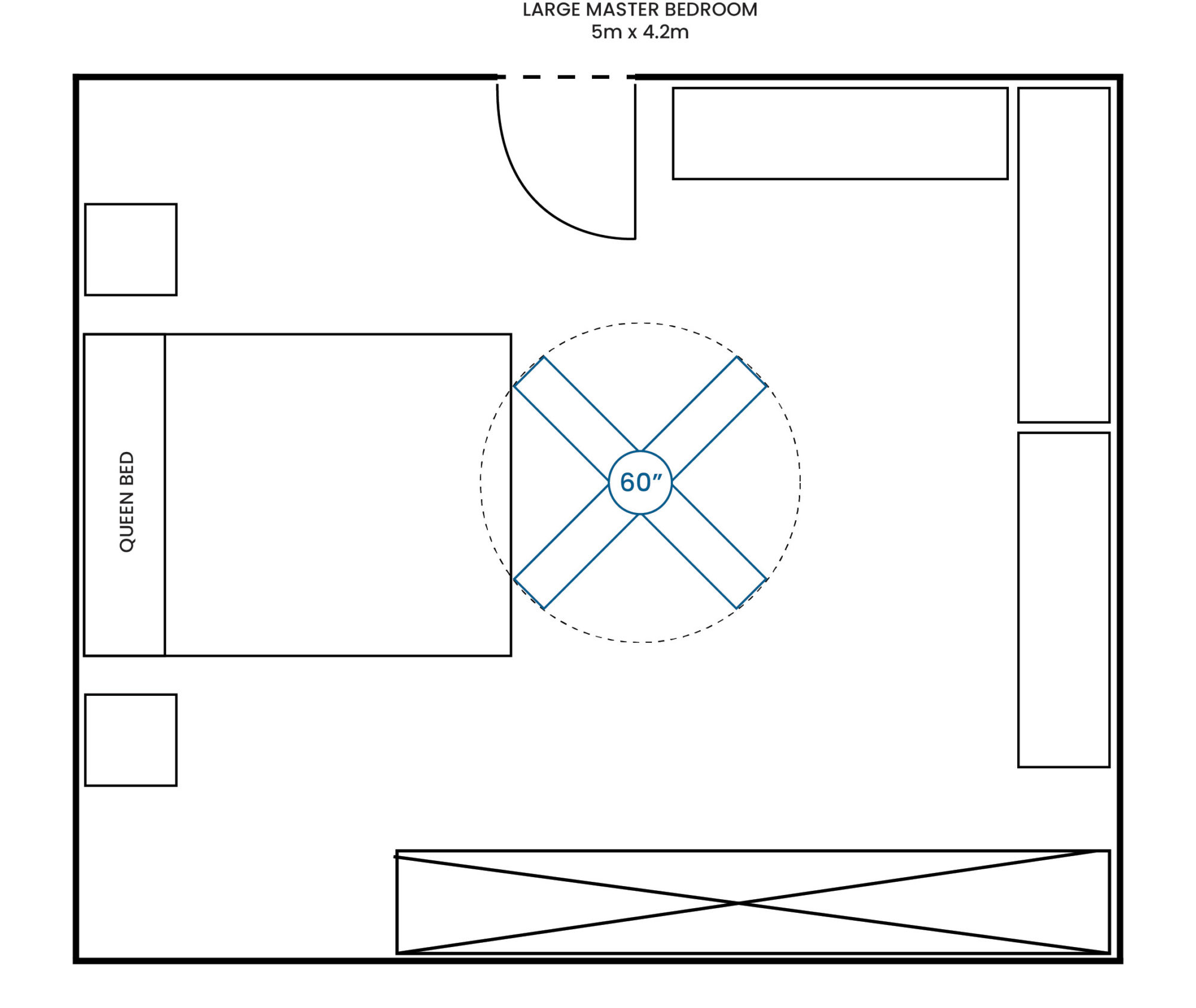
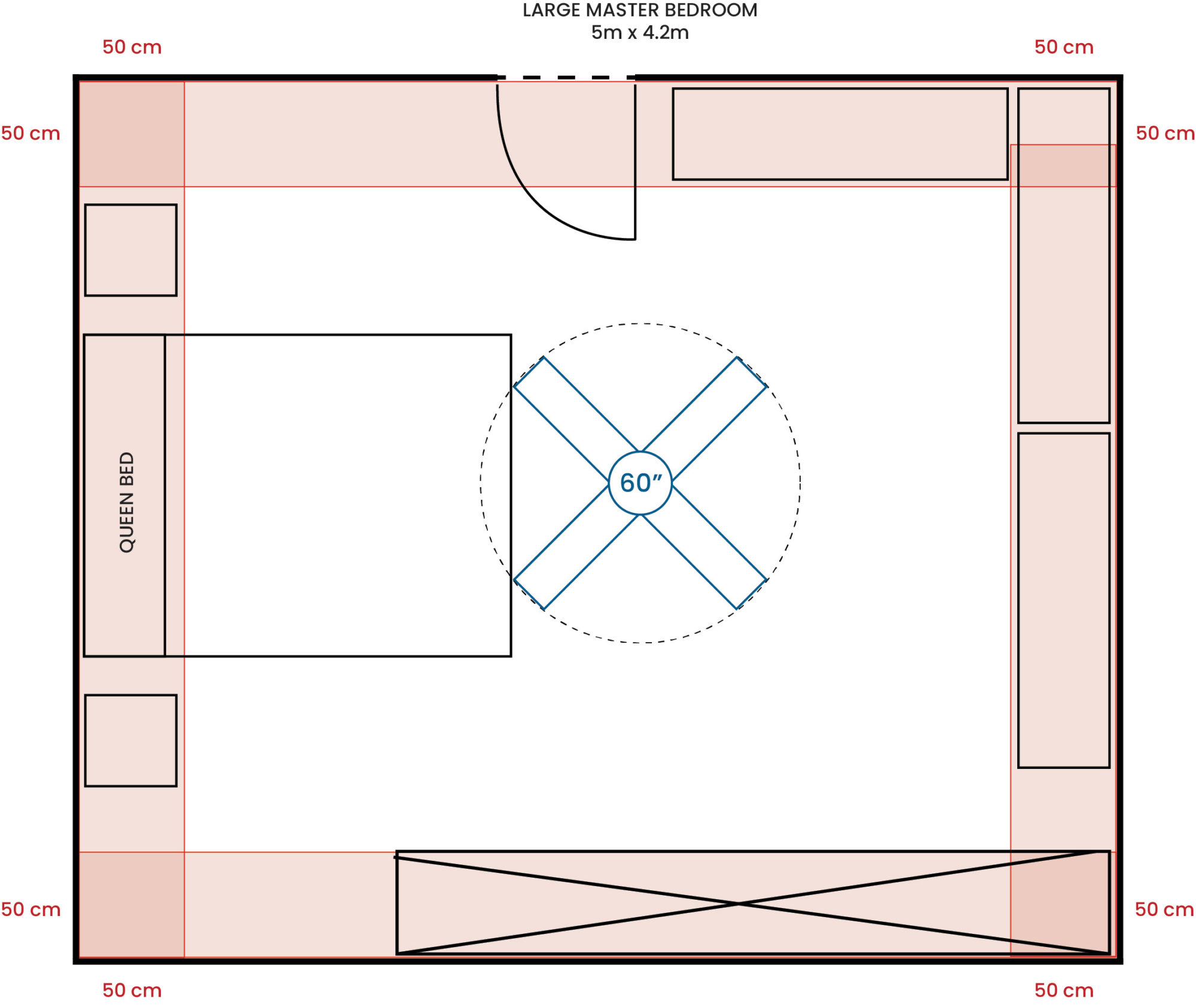
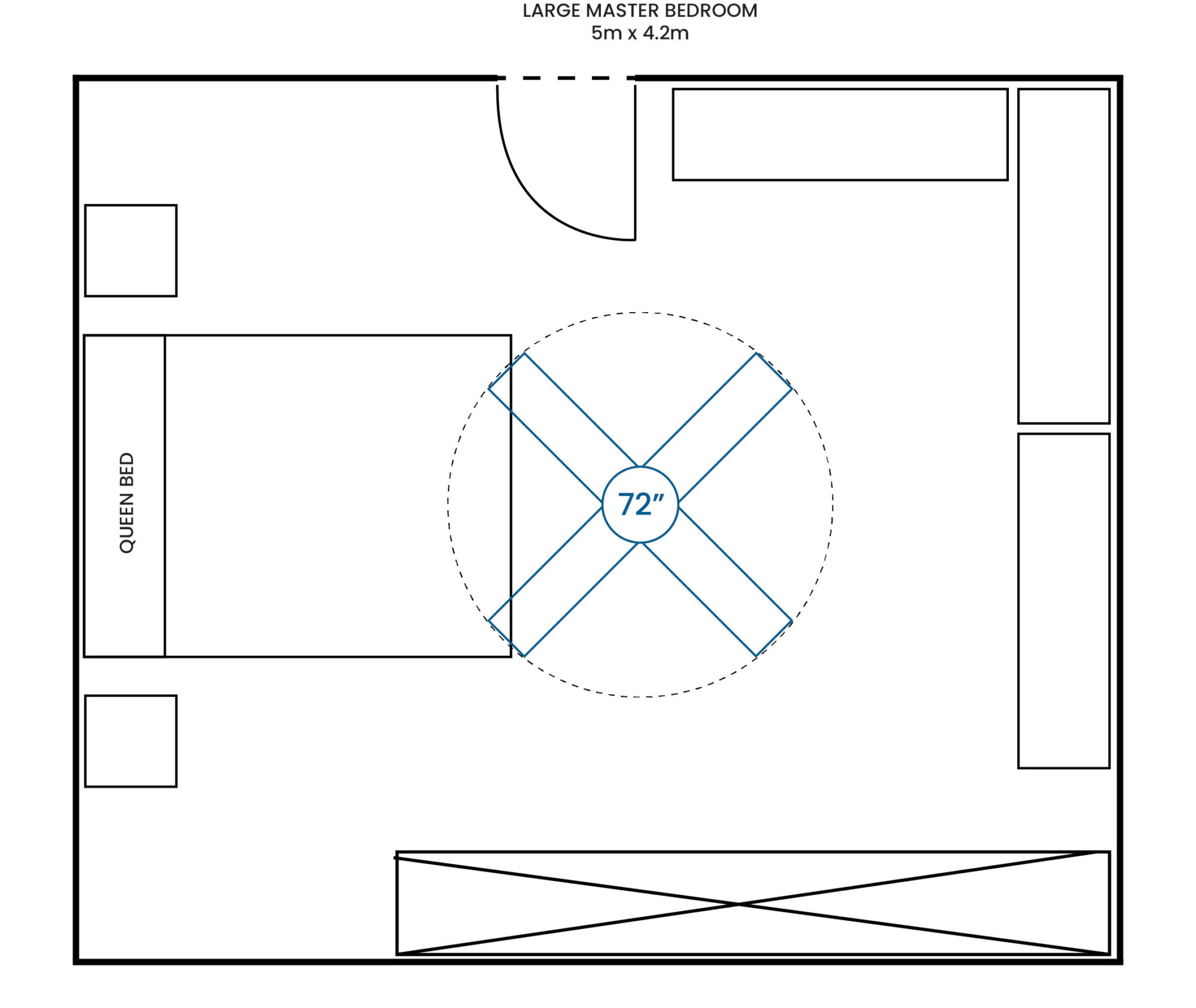
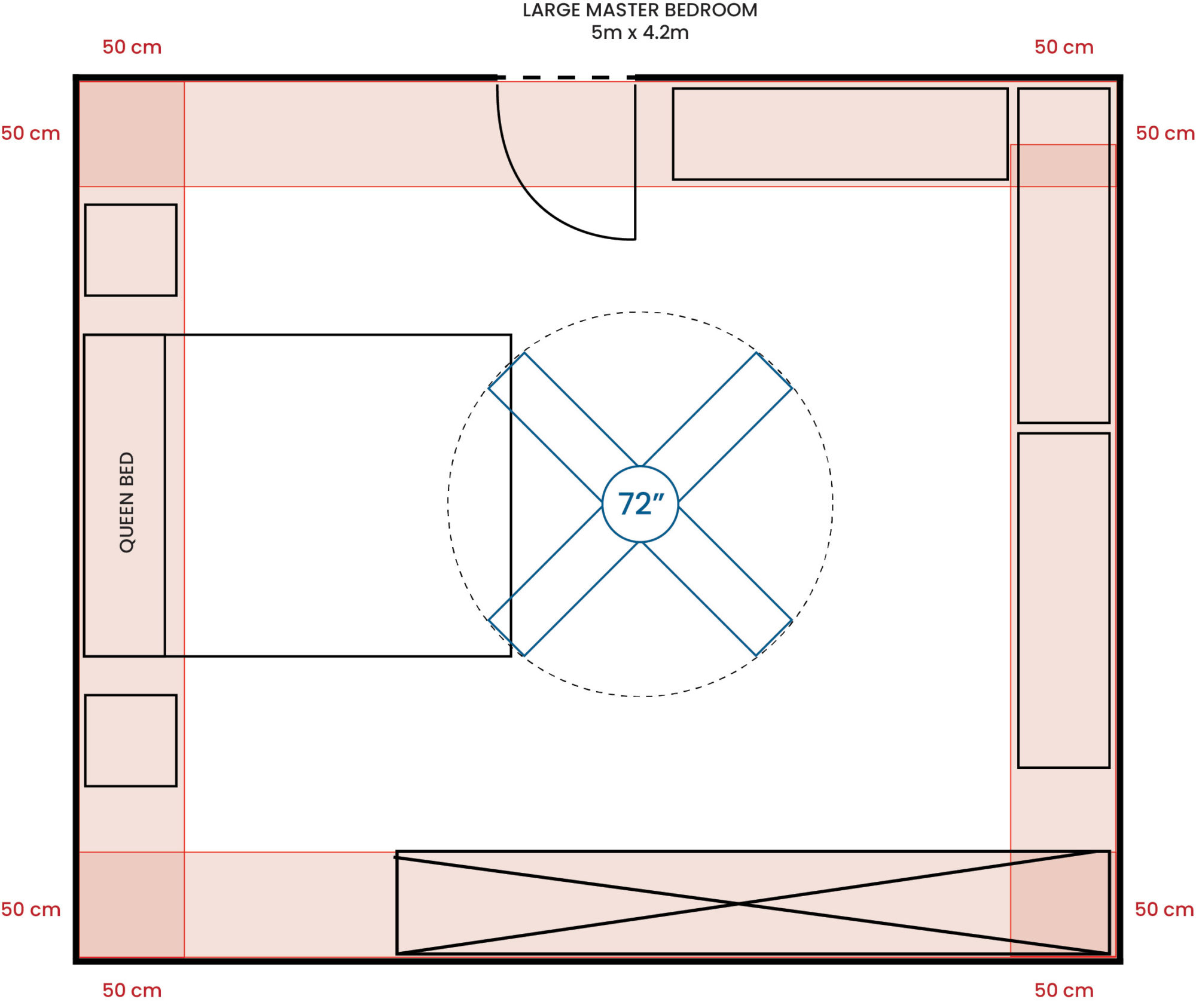
A Large Living Room that is 5.5m x 5m would suit models larger than 56″ in size, although the 56″ model would need to be well-positioned and would only provide localised cooling (e.g. over a couch). Depending on the type of cooling you are looking for, a larger ceiling fan may suit the space better but factor in the type of airflow and cooling you would prefer.



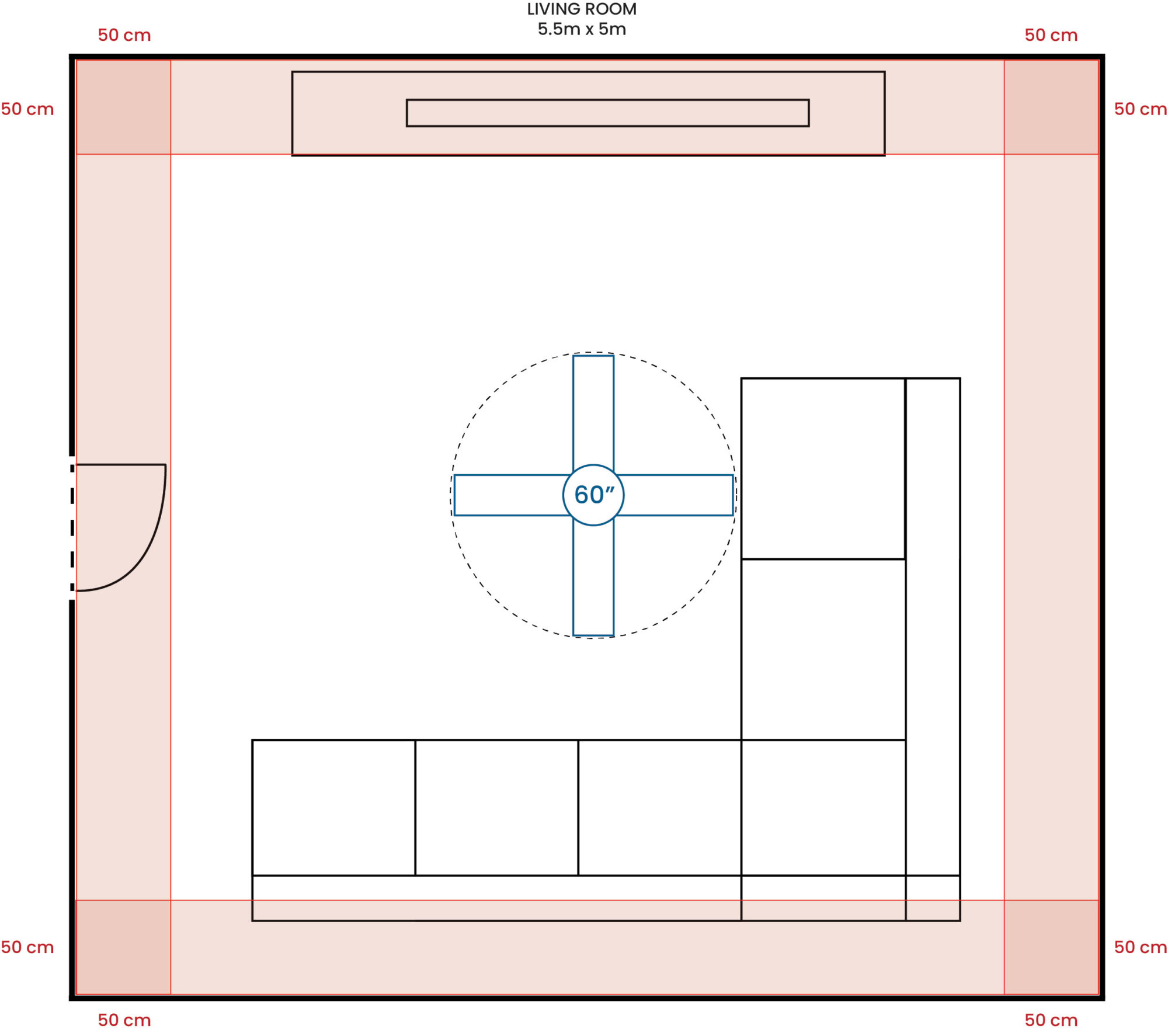
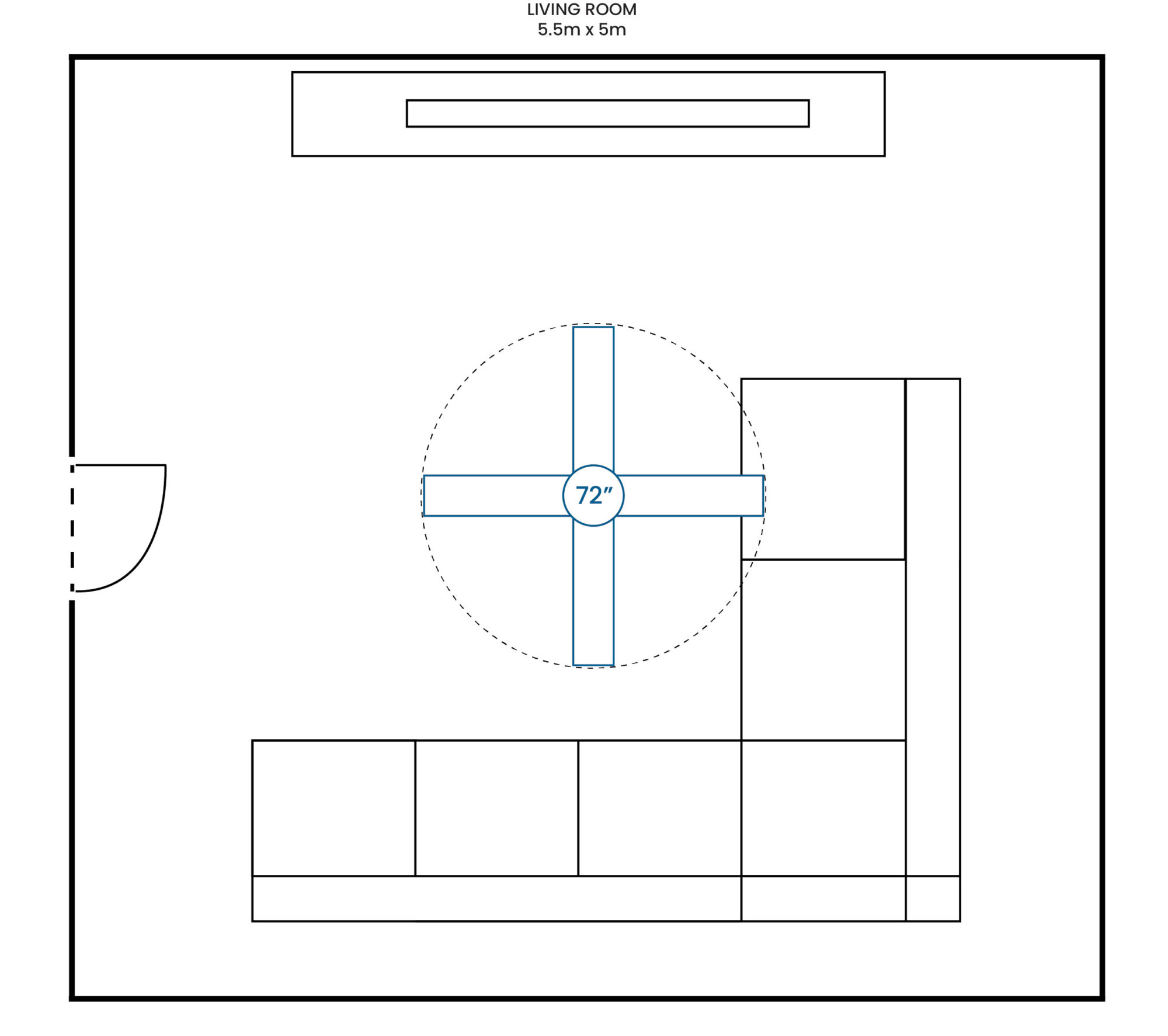


Hang your ceiling fan at an optimal height
One often overlooked variable in the performance of a ceiling fan is its distance both from where the air needs to be delivered but also the distance of the fan from the ceiling. While it makes sense that you want the breeze velocity from the fan close to where it is needed to create optimal wind chill and breeze, this air needs to come from somewhere.
Ceiling fans draw in air from above and force it down to create the breeze we feel. If there is a restriction of the available air above the blades for the fan to draw upon, this can create a vacuum effect and begin to draw the same air that is being displaced down, back up to the top of the fan. This results in a “cavitation” effect and impedes the performance of the fan. In most cases the ceiling fan provided to you in a box is not set to its optimum drop away from the ceiling, it is generally provided to you to be 30cm from the ceiling as this is the minimum height requirement on a standard 2.4m ceiling in Australia.
“Your ceiling fan blades must always be at least 2.1m from the floor to meet safety regulations.”
If you have the luxury in your space to be able to drop the fan down from the ceiling via a downrod it is advisable to do so to get the most out of your fan’s performance. For starters this gets the maximum velocity of the air forced closer to where it is needed, however, it is equally important for the fan to have as much unobstructed access to air from above to force it down efficiently.
“For high ceilings, try to position your ceiling fan between 2.4m and 2.7m from the floor.”
In terms of buying a downrod accessory for your ceiling fan, all our downrods are available in either 90cm or 180cm lengths and these can be cut to custom lengths by your installing electrician. The exact recommended downrod length for each ceiling height will vary slightly between models, as it depends on how deep the fan itself is. Refer to the ceiling fan’s Data Sheet as this will outline the distance from the ceiling to the bottom of the motor and blades for each model. This figure will be helpful in determining whether you will need a longer downrod, along with how long that downrod should be.
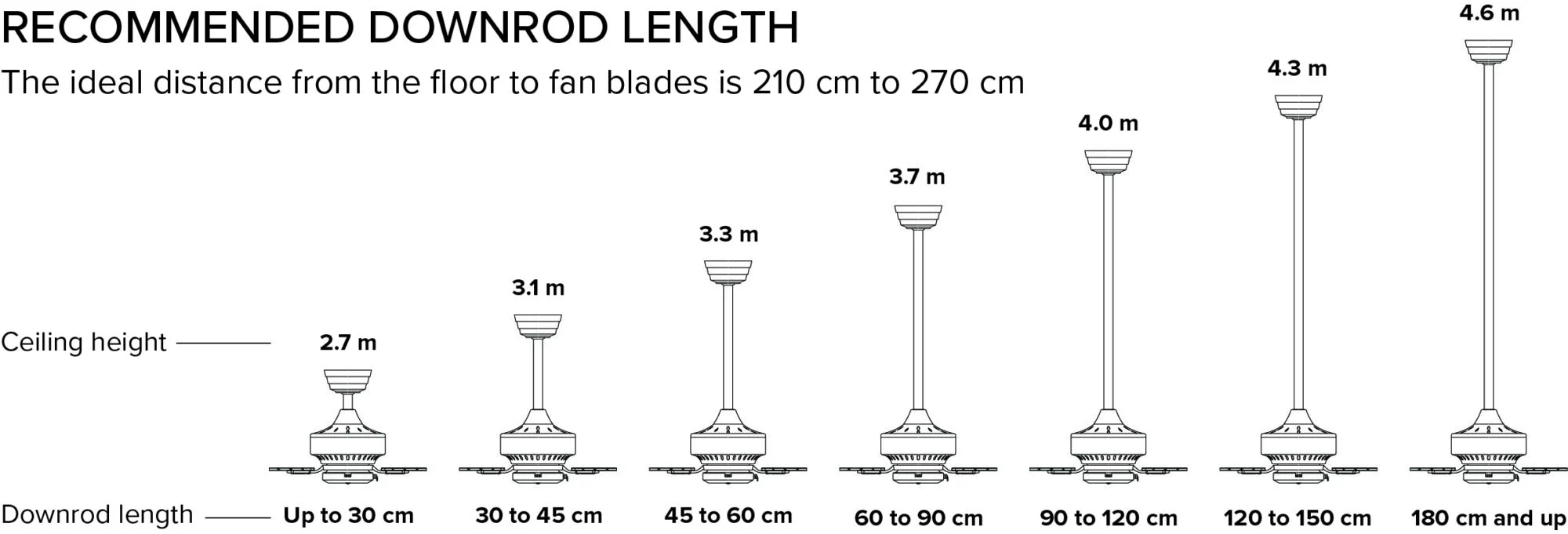
You can always get in touch with our friendly team should you have any questions or concerns about your specific installation requirements.
Consider your ceiling slope or angle
The recommended downrod lengths may change based on the slope or angle of your ceiling as high raked ceilings may require your fan to be dropped further to avoid the blades coming into contact with the ceiling.
Refer to our Sloped Ceiling Kits Guide for advice on whether you need an additional accessory.
